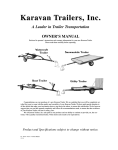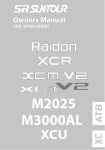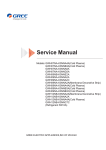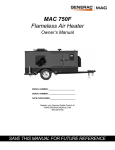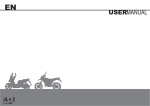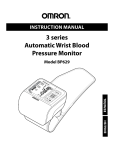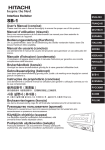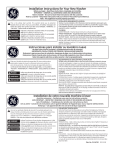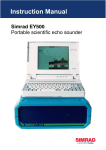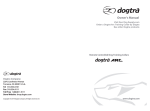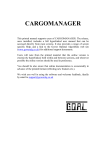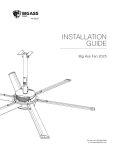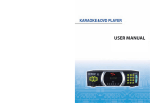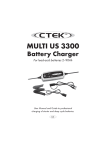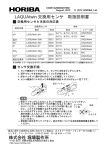Download MODEL #65001 Metal Utility Trailer User`s Manual and Maintenance
Transcript
1/09/2008 ® VISIT THE LIFETIME WEB SITE: WWW.LIFETIME.COM C op y Metal Utility Trailer MODEL #65001 User’s Manual and Maintenance Guide IMPORTADOR: Servicios Home Depot, S.A. de C.V. 5LFDUGR0DUJDLQ=R]D\D(GL¿FLR$ Fraccionamiento Parque Corporativo Santa Engracia Sand Pedro Garza García, N.L. C.P. 66267, México R.F.C.:SHD-940509-I58, Tel. 81 55 70 00 Warning: For safe operation of this trailer, be sure to read all instructions and warnings. Failure to follow instructions and warnings could result in property damage, serious injury and death. Instruction #1033986 B 1 In case we need to contact you about your trailer, please register on the Internet today at: C op y www.lifetime.com 2 Lifetime Products, inc. Metal Utility Trailer Model 65001 WARNING This User’s Manual contains safety information and instructions for your trailer. You must read this manual before loading or towing your trailer. You must follow all safety precautions and instructions. [email protected] 1+76$1RWL¿FDWLRQ6WDWHPHQW If you believe that your vehicle has a defect that could cause a crash or could cause LQMXU\RUGHDWK\RXVKRXOGLPPHGLDWHO\LQIRUPWKH1DWLRQDO+LJKZD\7UDI¿F6DIHW\ $GPLQLVWUDWLRQ1+76$LQDGGLWLRQWRQRWLI\LQJ/LIHWLPH3URGXFWV ,I1+76$UHFHLYHVVLPLODUFRPSODLQWVLWPD\RSHQDQLQYHVWLJDWLRQDQGLILW¿QGV that a safety defect exists in a group of vehicles, it may order a recall and remedy FDPSDLJQ+RZHYHU1+76$FDQQRWEHFRPHLQYROYHGLQLQGLYLGXDOSUREOHPV EHWZHHQ\RXDQG/LIHWLPH3URGXFWV 7RFRQWDFW1+76$\RXPD\HLWKHUFDOOWKH9HKLFOH6DIHW\+RWOLQHWROOIUHHDW 77<JRWRKWWSZZZVDIHUFDUJRYRUZULWHWR $GPLQLVWUDWRU1+76$1HZ-HUVH\$YHQXH6(:DVKLQJWRQ'& You can also obtain other information about motor vehicle safety from http://www. safercar.gov. &DOOWRUHDFKRXU&XVWRPHU6HUYLFHOLQH 3 Table of Contents SECTION 1: SAFETY INFORMATION SECTION 2: TRAILER PARTS & HARDWARE SECTION 3: PRE-TAKE-HOME ASSEMBLY SECTION 4: TRAILER ASSEMBLY 4.1 Secure Tongue 4.2 Attach Rear Floor Extension 4.3 Attach Front Panel 4.4 Attach Side Panels 4.5 Attach Rear Side Extension Panel 4.6 Attach Corner Guards 4.7 Attach Rear Gate 4.8 Attach State License Plate SECTION 5: TRAILER FEATURES SECTION 6: COUPLING TO THE TOW VEHICLE 6.1 Using an Adequate Tow Vehicle and Hitch 6.2 Coupling and Uncoupling the Trailer 6.2.1 Trailer with Ball-Hitch Coupler 6.2.1.1 Before coupling the trailer to the tow vehicle 6.2.1.2 Prepare the coupler and hitch 6.2.1.3 Coupling the trailer to the tow vehicle 6.2.1.4 Rigging the safety chains 6.2.1.5 Connecting the electrical cables 6.2.1.6 Uncoupling the Trailer SECTION 7: TIRE & SAFETY INFORMATION 7.1 Determining Correct Load Limit – Trailer 7.1.1 Trailers 10,000 Pounds GVWR or Less 7.2 Determining Correct Load Limit – Tow Vehicle 7.3 Glossary of Tire Terminology 7.4 Tire Safety - Everything Rides on It 7.4.16DIHW\¿UVW–Basic tire maintenance 7.4.2 Finding your vehicle’s recommended tire pressure and load limits 7.4.3 Understanding tire pressure and load limits 7.4.4 Checking tire pressure 7.4.5 Steps for maintaining proper tire pressure 7.4.6 Tire size 7.4.7 Tire tread 7.4.8 Tire balance and wheel alignment 7.4.9 Tire repair 7.4.10 Tire Fundamentals 7.4.10.1 Information on Passenger Vehicle Tires 7.4.10.2 UTQGS Information 7.4.10.3. Additional Information on Light Truck Tires 7.4.11 Tire Safety Tips 7.4.11.1 Preventing Tire Damage 4 7 11 14 18 18 20 22 24 26 32 33 35 36 40 40 40 40 41 41 41 42 43 44 45 45 45 45 45 48 49 49 49 50 50 50 51 51 51 51 51 53 53 54 54 7.4.11.2 Tire Safety Checklist 7.5 Changing a Flat Tire 7.6 Checking the Tire Pressure SECTION 8: LOADING THE TRAILER 8.1. Checking the Tongue Weight 8.1.1 Checking Tongue Weight — Using a lever and bathroom scale 8.2 Securing the Cargo 8.2.1 Loading Cargo 8.2.1.1 Preparing the Trailer for Loading 8.2.1.2 Loading the Trailer SECTION 9: CHECK TRAILER BEFORE & DURING TOWING SECTION 10: BREAKING IN A NEW TRAILER SECTION 11: MAINTENANCE 11.1 Inspection, Service & Maintenance Summary Charts 11.2 Inspection and Service Instructions 11.2.1 Axle Bolts, Frame, Suspension, & Structure 11.2.2 Trailer Structure 11.2.2.1 Fasteners and Frame Members 11.2.2.2 Welds 11.2.3 Trailer Connection to Tow Vehicle 11.2.3.1 Coupler and Ball 11.2.4 Landing Leg or Jack 11.2.5 Lights and Signals 11.2.6 Tires 11.2.7 Wheel Rims 11.2.8 Wheels, Bearings and Lug Nuts 11.2.8.1 Unsealed Bearings (Hubs) 11.2.9 Lug Nuts (Bolts) 54 54 57 58 60 60 60 60 61 61 63 65 66 66 67 67 68 68 68 69 69 69 69 70 70 70 70 71 5 7KLV3DJH,QWHQWLRQDOO\/HIW%ODQN 6 SECTION 1: SAFETY INFORMATION SAFETY ALERT SYMBOLS AND SIGNAL WORDS The safety information in this manual is denoted by the safety alert symbol: The level of risk is indicated by the following signal words: SIGNAL WORDS Warning Hazards or unsafe practices which COULD result in severe personal injury or death if the warning is ignored. Hazards or unsafe practices which could result in minor or moderate injury if the warning is ignored. ,IDODEHOEHFRPHVXQUHDGDEOH\RXFDQUHRUGHUWKHPIURP&XVWRPHU 6HUYLFH [email protected] Caution Warning Labels & Locations 2 2 1 6 3 5 1 7 Lug Nuts and Tire Pressure ADVERTENCIA WARNING Tire, wheel or lug nut failure can cause loss of control. Before towing, you must CHECK: 1. Tire pressure and tread. 2. Tires and wheels for damage. 3. Lug nuts for tightness. For new and remounted wheels, 5HWLJKWHQOXJQXWVDWWKH¿UVW 10, 25 and 50 miles of driving. Las fallas en las llantas, ruedas o tuercas a las llantas pueden provocar pérdida del control. Antes de realizar un acarreo, DEBE REVISAR: 1. Presión y costura de las llantas. 2. Daños en llantas y ruedas. 3. Tuercas a las llantas bien apretadas. Para llantas nuevas y reacondicionadas, apriete nuevamente las tuercas a las llantas a los primeros 16 kilómetros, 40,2 kilómetros y 80,5 kilómetros de manejo. Lug Nuts TIGHT? Tuercas a las llantas ¿BIEN APRETADAS? Tires and Wheels OK? Las llantas y ruedas ¿ESTÁN BIEN? © 2002 NATM # 1027939 1 5HRUGHU 7KHSURSHUWLJKWQHVVWRUTXHIRUOXJQXWVLVIWOE'RQRWH[FHHGIWOE Use a torque wrench to tighten the lug nuts. If you do not have a torque wrench, use DOXJZUHQFKIURP\RXUWRZYHKLFOHDQGWLJKWHQWKHQXWVDVPXFKDV\RXFDQ7KHQ KDYHDVHUYLFHJDUDJHRUWUDLOHUGHDOHUWLJKWHQWKHOXJQXWVWRWKHSURSHUWRUTXH6HH WKHVHFWLRQ³7LUHDQG6DIHW\,QIRUPDWLRQ´IRUPRUHGHWDLOVFRQFHUQLQJWLUHVDIHW\ /XJQXWVDUHDOVRSURQHWRORRVHQDIWHU¿UVWEHLQJDVVHPEOHG:KHQGULYLQJDQHZ WUDLOHURUDIWHUZKHHOVKDYHEHHQUHPRXQWHGFKHFNWRPDNHVXUHWKH\DUHWLJKWDIWHU WKH¿UVWDQGPLOHVRIGULYLQJDQGEHIRUHHDFKWRZWKHUHDIWHU )DLOXUHWRSHUIRUPWKLVFKHFNFDQUHVXOWLQDZKHHOSDUWLQJIURPWKHWUDLOHUDQGDFUDVK leading to death or serious injury. 2 Securely Latching the Trailer Gate CAUTION SECURE GATES BEFORE MOVING TRAILER PRECAUCIÓN ¡ASEGURE LOS PORTONES ANTES DE MOVER EL REMOLQUE! #1027932 5HRUGHU 8 (QVXUHODWFKHVRQWUDLOHUJDWHDUHVHFXUHGXULQJWRZ ing and when not in use. The trailer gate must be ORFNHGGRZQGXULQJXVHDQGGXULQJVWRUDJH)DLOXUH WRORFNJDWHVHFXUHO\FRXOGUHVXOWLQVHULRXVSURSHUW\ GDPDJHSHUVRQDOLQMXU\DQGGHDWK6HHWKHVHFWLRQ ³7UDLOHU)HDWXUHV´IRULQIRUPDWLRQUHJDUGLQJODWFKLQJ the trailer gate. Coupler, Load Weight and Distribution and Electrical Connections 3 WARNING ADVERTENCIA ADVERTENCIA WARNING Uncoupling will cause trailer to come loose from tow vehicle. You must: Attach hooks to tow vehicle Sujetar los ganchos al vehículo remolcador 1. CHECK that ball load rating is same or greater than coupler load rating. 2. CHECK that ball size is same as coupler. 3. CLOSE COUPLER CLAMP on ball. 4. LIFT coupler upwards to test that it will not separate from ball. 5. LOCK coupler clamp with pin or padlock. El desenganche hará que el remolque quede suelto del vehículo remolcador. Usted deberá: Pin or padlock 1. VERIFICAR que la CAPACIDAD DE CARGA de la bola sea igual o mayor que la Enough slack In place CAPACIDAD DE CARGA del enganche. For turns Colocar el candado o 2. VERIFICAR que el tamaño de la bola sea igual que el enganche. 6X¿FLHQWHPHQWH gancho 3. CERRAR el TORNILLO DE AJUSTE DEL ENGANCHE sobre la bola. Cross chains ÀRMRSDUDSRGHU Lift coupler to check 4. LEVANTAR el enganche para probar que no se separe de la bola. Cruzar las cadenas girar /HYDQWDUHOHQJDQFKHSDUDYHUL¿FDU 5. CERRAR el tornillo de ajuste del enganche con un gancho o candado. Open Abierto Closed Cerrado WARNING ADVERTENCIA WARNING Improper loading can cause trailer sway and sudden loss of control. You must: Always use safety chains. Balance load side to side Secure load to trailer DISCONNECTED Chains hold trailer if connection fails. You must: Asegurar la carga Balancear la carga de lado a lado • Ensure weight of load plus trailer weight does not exceed trailer’s capacity DESCONECTADAS (GVWR - Gross Vehicle Weight Rating). 1. CROSS chains underneath coupler. al remolque • Load heavier items in front of wheels. 2. ALLOW slack for trailer to turn. • Load evenly side to side. 3. ATTACH chain hooks securely to tow vehicle frame. Less load in rear • Secure load to trailer. Utilice siempre cadenas de seguridad. Las cadenas Una carga impropia puede causar que el remolque se tambalee o que Menos carga sobre la sostienen el remolque en caso de que la conexión falle. parte posterior de las repentinamente pierda el control. Usted deberá: Usted deberá: • Asegurar que el peso de la carga más el peso del remolque no exceda la ruedas 1. CRUZAR las cadenas por debajo del enganche. capacidad del remolque (Clase de Peso del Vehículo). 2. PERMITIRTXHODVFDGHQDVTXHGHQÀRMDVSDUDTXH • Cargar los elementos más pesados en la parte delantera de las ruedas. el remolque pueda girar. More load in front of wheels • Cargar de forma equitativa de lado a lado. 3. SUJETAR de forma segura los ganchos de la Más carga sobre la parte delantera de las ruedas • Asegurar la carga al remolque. #1031540 cadena a los bordes del vehículo remolcador. CONNECTED CONECTADAS ADVERTENCIA Lights can prevent trailer from being hit by other vehicles. You must: 1. CONNECT trailer and tow vehicle electrical connectors. 2. CHECK all lights: tail lights, turn signals, and brake lights. 3. DO NOT TOW if lights are not working. Las luces pueden prevenir que otros vehículos choquen el remolque. Usted deberá: 1. CONECTAR los conectores eléctricos del remolque y del vehículo remolcador. 2. VERIFICAR todas las luces, las luces traseras, las luces de guiño, y las luces del freno. 3. NO UTILICE EL REMOLQUE si las luces no funcionan. 5HRUGHU /RDGV FDQ VXGGHQO\ PRYH RU WRSSOH ZKLFK FDQ UHVXOW LQ GHDWK RU VHULRXV LQMXU\ Overloaded trailers and improper tongue weight can result in loss of control of the WUDLOHU (QVXUH WKH WUDLOHU LV FRXSOHG FRUUHFWO\ DQG WKH FKDLQV FURVV RYHU HDFK RWKHU (QVXUHWKHORDGLVWLHGVHFXUHO\DQGGRHVQ¶WH[FHHGWKH*URVV9HKLFOH:HLJKW*9: 2000 lb. (QVXUHWKHHOHFWULFDOFRQQHFWLRQVDUHWLJKWO\¿WWHGDQGIXQFWLRQLQJSURSHUO\$OZD\V FKHFNEUHDNOLJKWVDQGWXUQVLJQDOVEHIRUHHDFKWRZ Ball and Hitch Size V IS E ! LA GAN CHE O EN DE UN ¡RE 5,08 cm # 102793 1 MOLQUE RE NE TIE ESTE ATENCIÓN SU B 5HRUGHU <RXUQHZWUDLOHUFRPHVZLWKD´FRXSOHU7KHEDOORQWKHWRZYHKLFOHPXVWEH inches in diameter. An incorrect ball size can cause the separation of the trailer from the tow vehicle resulting in possible property damage, serious injury and death. 9 5 Tire and Loading Information MFD BY: LIFETIME PROD. INC. FABRICADO POR: LIFETIME PROD. INC. GVWR: TIRE RIM (IN) GAWR NEUMÁTICO LLANTA (CM) COLD INFLATION PRESSURE PRESIÓN DEL NEUMÁTICO EN FRÍO PSI (KPA) DATE/FECHA: 800.225.3865 SGL/DUAL ÚNICO/DOBLE SINGLE/ÚNICO THIS VEHICLE CONFORMS TO ALL APPLICABLE U.S. FEDERAL MOTOR VEHICLE SAFETY STANDARDS (FMVSS) IN EFFECT ON THE DATE OF MANUFACTURE SHOWN ABOVE. ESTE VEHÍCULO CUMPLE CON TODAS LAS NORMAS FEDERALES DE SEGURIDAD VIGENTES EFECTIVO EN LA FECHA DE FABRICACIÓN MOSTRADA ARRIBA. TYPE OF VEHICULE: V.I.N/N.I.V. TIPO DE VEHÍCULO: TIRE AND LOADING INFORMATION INFORMACIÓN SOBRE NEUMÁTICOS Y CARGA El peso del cargamento nunca deberá exceder los NEUMÁTICO TAMAÑO kg. PRESIÓN DEL NEUMÁTICO EN FRÍO VEA EL MANUAL DEL USUARIO PARA INFORMACIÓN ADICIONAL The weight of cargo should never exceed TIRE SIZE lbs. COLD TIRE PRESSURE SEE OWNER’S MANUAL FOR ADDITIONAL INFORMATION # 1027940 B 1RUHRUGHUV $OZD\VFKHFNWLUHSUHVVXUHWRHQVXUHRSWLPXPOLIHDQGSHUIRUPDQFHIURP\RXUWLUHV 7KHWLUHVWKDWFDPHZLWK\RXUWUDLOHUVKRXOGKDYHDWLUHSUHVVXUHRISVL/LIHWLPH 3URGXFWVFDQQRWEHKHOGUHVSRQVLEOHIRUGDPDJHVFDXVHGE\XQHYHQWUHDGZHDUDQG EORZRXWVIURPDQXQGHULQÀDWHGRURYHULQÀDWHGWLUH 7KHORDGVKRXOGQHYHUH[FHHGWKH*URVV9HKLFOH:HLJKWRIOE:KHQHYHU ORDGLQJWKHWUDLOHUDOZD\VFKHFNWRVHHLI\RX¶UHZLWKLQWKLVOLPLW6HHWKHVHFWLRQ ³/RDGLQJWKH7UDLOHU´IRULQIRUPDWLRQUHJDUGLQJKRZWRFKHFN 7KLVVWLFNHUDOVRGLVSOD\V\RXU9HKLFOH,GHQWL¿FDWLRQ1XPEHU9,1LQWKHERWWRP OHIWKDQGFRUQHU 6 NATM Compliance 5HRUGHU Patent Advisory 1RUHRUGHUV 7KLVVWLFNHUGLVSOD\VWKHYDULRXVSDWHQWV Your trailer is in compliance with the guidelines of the National Association of applicable to the trailer. Trailer Manufacturers. Your trailer has its own unique number. Note: This is not \RXU9HKLFOH,GHQWL¿FDWLRQ1XPEHU9,1 10 SECTION 2: TRAILER PARTS & HARDWARE PARTS LIST ID Part # $$ $% $, $& $' $( AF 1013282 $* $+ $. $/ Parts Bag (1024674) %$ %* %, Hardware Bag (1018013) %% %) Hardware Bag (1018014) %& %) Hardware Bag (1018015) %( %) Hardware Bag (1022647) %' %+ %1 Description 7RQJXH´&RXSOHU-DFN$VVHPEO\ 5LJKW6LGH3DQHO /HIW6LGH3DQHO /HIW5HDU6LGH([WHQVLRQ3DQHO 5LJKW5HDU6LGH([WHQVLRQ3DQHO )URQW3DQHO Tailgate 7UDLOHU%HG 5HDU%HG([WHQVLRQ &RWWHU.H\ ´[´+H[%ROW Qty 1 &RUQHU*XDUG [´6HOI7DSSLQJ6FUHZ *XDUG5DLO6OHHYH ´;´+H[%ROW ´1\ORFN1XW ´;´+H[%ROW ´1\ORFN1XW ´;´+H[%ROW ´1\ORFN1XW ´)ODW:DVKHU ´1\ORFN1XW TOOLS NEEDED (NOT INCLUDED) (OHFWULF'ULOO ´'ULOO%LW 3KLOOLSV%LW 6RFNHW:UHQFKZLWK´VKDOORZVRFNHW5HFRPPHQGHGRU´2SHQIDFH :UHQFKRU$GMXVWDEOH:UHQFK 5XEEHU0DOOHW5HFRPPHQGHGRU+DPPHU 6. Utility Knife ´/XJ:UHQFKRU7LUH,URQ)RUSHULRGLFWLJKWHQLQJRIOXJQXWV ´:UHQFKRU6RFNHW:UHQFK ´:UHQFKRU6RFNHW:UHQFKZLWK´6RFNHW 11 HARDWARE IDENTIFIER Note: The hardware is in clear plastic bags within the plastic bag labeled ORFDWHGXQGHUD5HDU6LGH([WHQVLRQ$&RU$'RQWKH7UDLOHUEHG *Note:3DUWVDUHDFWXDOVL]HXQOHVVQRWHGRWKHUZLVH %HIRUHEHJLQQLQJDVVHPEO\LQYHQWRU\DOOSDUWVXVLQJWKH3DUWV/LVWEHORZDQGWKH +DUGZDUH,GHQWL¿HUQH[WWZRSDJHV,IDOOSDUWVDUHQRWSUHVHQWGR127DVVHPEOH WKHWUDLOHU&DOO/LIHWLPH3URGXFWVDWWKHQXPEHURQWKHFRYHURIWKLVPDQXDO BE (6) BC (7) BB (11) BF (24) *BI (2) BG (4) *BA (2) *AK (2) BH (2) BD (8) *Not to Scale 12 AL (2) *AC (Left) *AE *AD (Right) *AB (Right) *AI (Left) *AH *AF *AA *AG 13 SECTION 3: PRE-TAKE-HOME ASSEMBLY Hardware Used: *AK (2) *AL (2) *Not actual size **At Least 2 Adults Required for the Following Steps** %HIRUHWRZLQJ\RXUWUDLOHUKRPH\RXPXVW¿UVWDVVHPEOHWKHWRQJXH<RXPXVWVOLGHWKH WRQJXHRXWDQGORFNLWLQSODFHEHIRUHDWWDFKLQJWKHWUDLOHUWR\RXUWRZYHKLFOH Note:,I\RX¶YHDOUHDG\WRZHG\RXUQHZWUDLOHUKRPHVNLSWRWKHVHFWLRQ “Trailer Assembly” to continue. 3.1&KRFNWKH7LUHVIURQWDQGUHDUZLWKEULFNVRUZRRGHQEORFNV 3.2:KLOHRQHDGXOWVXSSRUWVWKH7UDLOHUUHPRYHWKHWZRCotter Keys (AK) holding the 1/2”-13 x 4 1/2” Hex Bolts (AL) and Tongue (AA) in place. Remove the two Bolts and slide Tongue forward from under Trailer Bed until the holes in the Tongue are centered with the holes in the Tongue Attachment Plates. Warning: Be careful when removing pins. Tongue could fall causing serious injury. AK AK AA Tongue Attachment Plates Center holes in Tongue with holes in Attachment Plates. 3.35HLQVHUWBolts and replace the Cotter Keys to secure the Tongue in place. AK AK Use upper hole AL AL Re-insert Cotter Keys to shaded points as in illustrations 14 WARNING 'R127UHPRYHRUORRVHQEDQGLQJXQWLO\RX¶UHUHDG\WR assemble the trailer. If you loosen the banding, trailer parts may dislodge, fall off the trailer during towing and cause an accident. Failure to follow this warning could result in property damage, serious injury and death. Lug Nuts: Tightening Sequence, Torque Requirements WARNING /XJQXWVDUHSURQHWRORRVHQDIWHULQLWLDOLQVWDOODWLRQSRVVLEO\FDXVLQJ the wheel to separate from the trailer leading to property damage, death or serious injury. &KHFNOXJQXWVIRUWLJKWQHVVRQDQHZWUDLOHURUZKHQZKHHOVKDYH EHHQUHPRXQWHGDIWHUWKH¿UVWDQGPLOHVRIGULYLQJDQG after any impact. /XJQXWVIRUWKHWLUHVPXVWEHWLJKWHQHGE\WKHXVHUEHIRUHHDFKXVH /LIHWLPH3URGXFWVFDQQRWEHKHOGUHVSRQVLEOHIRUGDPDJHVFDXVHGE\ loosened lug nuts. • Before towing the Trailer, you must ensure the lug nuts are tightened to the proper torque. • The torque requirements for the Lug Nuts are 95 - 120 ft./lb'RQRWH[FHHG ft./lb of torque. Tighten the Lug Nuts in the sequence below before you leave the dealer. 9HULI\WKHSURSHU36,IRU\RXUWLUH 7LUHSUHVVXUHIRUD´ULPWLUHVKRXOGEHDW80 psi. 1 Tighten lug nuts in the following order: 4 3 5 2 15 WARNING Improper rigging of the safety chains can result in loss of control of the trailer and the tow vehicle, leading to death or serious injury, if the trailer uncouples from the tow vehicle. )DVWHQFKDLQVWRIUDPHRIWRZYHKLFOH'RQRWIDVWHQFKDLQWRDQ\ part of the KLWFKXQOHVVWKHKLWFKKDVKROHVRUORRSVVSHFL¿FDOO\IRUWKDWSXUSRVH &URVVFKDLQVXQGHUQHDWKKLWFKDQGFRXSOHUZLWKHQRXJKVODFNWR permit turning, and to hold tongue up, if the trailer comes loose. To help ensure your safety as well as other drivers’ safety, you must correctly hitch \RXUQHZ7UDLOHUWRWKH7RZ9HKLFOH<RXUQHZWUDLOHUFRPHVZLWKD2-inch Coupler. The tow vehicle must have a 2-inch Ball to match. &URVVWKHFKDLQVDQGLQVHUWHDFKHQGWKURXJKWKH7RZ9HKLFOH¶VKLWFK&RQQHFWKRRN WRFKDLQDVLOOXVWUDWHG Follow local and state speed limit laws, but do not exceed 65 mph. 3UHVVGRZQ WRORFN &URVVFKDLQVRYHURQHDQRWKHU before securing to tow vehicle. Connecting the Electrical Cables &RQQHFWWKHWUDLOHUOLJKWVWRWKHWRZYHKLFOH¶VHOHFWULFDOV\VWHPXVLQJWKHHOHFWULFDO connectors. &KHFNDOOOLJKWVIRUSURSHURSHUDWLRQ &OHDUDQFHDQG5XQQLQJ/LJKWV7XUQRQWRZYHKLFOHKHDGOLJKWV %UDNH/LJKWV6WHSRQWRZYHKLFOHEUDNHSHGDO 7XUQ6LJQDOV2SHUDWHWRZYHKLFOHGLUHFWLRQDOVLJQDOOHYHU %DFNXS/LJKWV3XWWRZYHKLFOHJHDUVKLIWLQWRUHYHUVH 7RHQVXUH\RXUWUDLOHUOLJKWVIXQFWLRQSURSHUO\¿UPO\LQVHUWWKHMale Plug (Trailer) into the Female Receptor (Tow Vehicle). From Trailer 16 From Tow Vehicle From Tow Vehicle From Trailer WARNING &KHFNWKHFRQQHFWLRQSHULRGLFDOO\WRHQVXUHWDLODQGEUHDNOLJKWV function properly. Failure to follow this warning could result in property damage, serious personal injury and death. Note: ,I\RXVWLOOKDYHWKHIRXUZRRGHQEORFNVEROWHGWRWKHIRXUFRUQHUEUDFNHWVRI WKHWUDLOHUUHPRYHWKHPXVLQJD´ZUHQFK Connecting Temporary License Plate If your state requires a temporary license on your trailer, secure the license to the OLFHQVHSODWHKROGHUORFDWHGRQWKHOHIWEOLQNHUEHIRUHWRZLQJ\RXUWUDLOHUKRPH Temporary /Lcense WARNING 'R127UHPRYHRUORRVHQEDQGLQJXQWLO\RX¶UHUHDG\WR assemble the trailer. If you loosen the banding, trailer parts may dislodge, fall off the trailer during towing causing an accident. Failure to follow this warning could result in property damage, serious personal injury and death. Note: For all inquiries regarding trailer title and registration, please contact your ORFDO'HSDUWPHQWRI0RWRU9HKLFOHV'09RU\RXUORFDOFRXQW\WD[DVVHVVRU¶V RI¿FH WARNING 'RQRWWUDQVSRUWSHRSOHLQWKHWUDLOHU)DLOXUHWRKHHGWKLVZDUQ LQJFRXOGUHVXOWLQVHULRXVLQMXU\VXFKDVEURNHQERQHVEUDLQ damage, paralysis or death. 17 SECTION 4: TRAILER ASSEMBLY Hardware Used: *AL (2) ´6RFNHW:UHQFK BH (2) ´:UHQFK *AK (2) Hardware Bag: 1022647 *Not actual size **At Least 2 ADULTS Required for the Following Steps** ,I \RX KDYHQ¶W GRQH VR DOUHDG\ ¿UVW DVVHPEOH WKH WRQJXH EHIRUH WRZLQJ \RXU WUDLOHU home. Refer to the section ³3UH7DNH+RPH$VVHPEO\´. 4.1 Secure Tongue 4.1.1&KRFNWKH7LUHVIURQWDQGUHDUZLWKEULFNVRUZRRGHQEORFNV 4.1.2:KLOHRQHDGXOWVXSSRUWVWKH7UDLOHUUHPRYHWKHWZRCotter Keys (AK) holding the Bolts (AL) and Tongue (AA) in place. Warning: Be careful when removing pins. Tongue could fall causing serious injury. AK AK AA Tongue Attachment Plates 18 Center holes in Tongue with holes in Attachment Plates. 4.1.3 Replace the Cotter Keys ZLWKWZR 1/2”-13 Nylock Nuts (BH) to secure the TongueLQSODFH'LVFDUGCotter Keys. BH BH Use upper hole AL AL 19 Hardware Needed: BF (3) ´6RFNHW:UHQFK ´:UHQFK BC (3) Rubber Mallet Hardware Bag: 1018014 Utility Knife **At Least Two ADULTS Required for Assembly** Before beginning this step, use a Utility Knife to cut the banding around Trailer. Important: :KLOH DQRWKHU DGXOW SUHYHQWV WKH 5HDU )ORRU ([WHQVLRQ IURP IDOOLQJ carefully remove all loose parts from the bed of the Trailer. Inventory all parts and KDUGZDUH WR HQVXUH \RX UHFHLYHG DOO QHFHVVDU\ SLHFHV 7KH 3DUWV /LVW DQG +DUGZDUH ,GHQWL¿HUDUHORFDWHGRQSDJHV 4.2 Attach Rear Floor Extension 4.2.1 Rotate and lower the Tongue JackLQWRSRVLWLRQDQGFKRFNWKHWheels6HHWKH VHFWLRQ³7UDLOHU)HDWXUHV´IRUGHWDLOVRQXVLQJWKH7RQJXH-DFN 4.2.2&DUHIXOO\OLIWWKHRear Bed Extension (AH) off the Trailer Bed and attach to the EDFNRIWKHWUDLOHU WARNING: Watch for pinch points as serious injury could occur. AH Rear Floor Extension Be careful not to damage the wiring insulation (the colored plastic around WKHZLUHV Tongue Jack 20 4.2.3:KLOHDQRWKHUDGXOWKROGVWKH5HDU%HG([WHQVLRQLQSODFHVHFXUHWKHRear Bed ExtensionWRWKHEDFNRIWKHTrailer BedXVLQJWKUHH3/8”-16 x 2 3/4” Hex Bolts (BC)DQGWKUHH3/8”-16 Nylock Nuts (BF). Note: If necessary, after aligning the holes gently tap the Bolt with a Rubber Mallet or Hammer to help pass the Bolts through the holes. DO NOT COMPLETELY TIGHTEN THE NYLOCK NUTS YET. BC BF 4.2.46WDUWLQJDWWKH&RXSOHURQWKH7RQJXHJHQWO\SXOOExcess wireIURPWKHEDFNRI WKH7UDLOHUWKURXJKWKHFHQWHU&RQGXLWDQGLQWRWKH7RQJXH 4.2.57XFNDQ\Excess WireH[WHQGLQJRXWRIWKH&RXSOHUEDFNXQGHUQHDWKWKH &RXSOHUDQGLQWRWKH7RQJXH Coupler Wiring Housing Be careful not to damage the insulation (colored plastic) around the wires. 21 4.3 Attach Front Panel 4.3.1 6OLGH WKH Front Panel (AE) down between the two front Center Support Brackets of the Trailer Bed. WARNING: Watch for pinch points as serious injury could occur. Center Support AE Center Support Brackets 22 Hardware Needed: BB (1) ´6RFNHW:UHQFK ´:UHQFK BF (1) Rubber Mallet Hardware Bag: 1018013 4.3.2,QVHUWRQH3/8”-16 x 2 1/2” Hex Bolt (BB)DQGRQH3/8”-16 Nylock Nut (BF). Note: If necessary, after aligning the holes gently tap the Bolt with a Rubber Mallet or Hammer to help pass it through the holes. BF BF BB BB DO NOT COMPLETELY TIGHTEN THE NYLOCK NUTS YET. CAUTION Be careful when standing in the Trailer. The Trailer Bed may be slippery when wet causing you to fall. 23 4.4 Attach Side Panels 4.4.16OLGHWKHLeft Side Panel (AI)GRZQLQWRSRVLWLRQVRWKH&HQWHU3RVW¿WVEHWZHHQ WKHVLGH&HQWHU6XSSRUW%UDFNHWV WARNING: Watch for pinch points as serious injury could occur. AI Note:/LIHWLPHORJRJRHVWRZDUGVWKH front of the Trailer. Center Post Side Center Support Brackets 24 Hardware Needed: BB (4) ´6RFNHW:UHQFK BF (4) ´:UHQFK Hardware Bag: 1018013 Rubber Mallet BF (6) BD (6) Hardware Bag: 1022647 BE (6) Hardware Bag: 1018015 4.4.26WDUWLQJDWWKHERWWRPKROHVHFXUHWKH6LGH3DQHOWRWKH)URQW3DQHOXVLQJWKUHH 3/8”-16 x 3 3/4” Hex Bolts (BE)WKUHH3/8” Flat Washers (BD)DQGWKUHH 3/8”-16 Nylock Nuts (BF). 4.4.36WDUWLQJDWWKHERWWRPKROHVHFXUHWKH6LGH3DQHOWRWKH6LGH&HQWHU6XSSRUW %UDFNHWVXVLQJWZR3/8”-16 x 2 1/2” Hex Bolts (BB)DQGWZR3/8”-16 Nylock Nuts (BF). 4.4.4 Repeat steps 4.4.1 - 4.4.3IRUWKHRWKHU6LGH3DQHO Note: If necessary, after aligning the holes gently tap the Bolts with a Rubber Mallet or Hammer to help pass them through the holes. BF BE BF BB BD DO NOT COMPLETELY TIGHTEN THE NYLOCK NUTS YET. 25 Hardware Needed: BC (2) ´6RFNHW:UHQFK BI (2) ´:UHQFK BF (2) Rubber Mallet Hardware Bag: 1018014 Parts Bag: 1024674 4.5 Attach Rear Side Extension Panels 4.5.1:KLOHVOLGLQJWKHLeft Rear Side Extension (AC) down into position, insert one Guard Rail Sleeve (BI)EHWZHHQWKHWZRUDLOVDVVKRZQ:KHQORRNLQJIURPWKH EDFNRIWKH7UDLOHUWKH/HIW5HDU6LGH([WHQVLRQJRHVRQWKHULJKWVLGH AC BI BI 26 4.5.26HFXUHWKHLeft Rear Side Extension Panel (AB)WRWKH%HG([WHQVLRQXVLQJWZR 3/8”-16 x 2 3/4” Hex Bolts (BC)DQGWZR3/8”-16 Nylock Nuts (BF). Note: If necessary, after aligning the holes gently tap the Bolts with a Rubber Mallet or Hammer to help pass them through the holes. WARNING: Watch for pinch points as serious injury could occur. BC BF DO NOT COMPLETELY TIGHTEN THE NYLOCK NUTS YET. 27 Hardware Needed: BB (3) ´6RFNHW:UHQFK BF (3) ´:UHQFK BD (1) Rubber Mallet Hardware Bag: 1018013 Hardware Bag: 1022647 4.5.36WDUWLQJDWWKHERWWRPKROHVHFXUHWKH/HIW5HDU6LGH([WHQVLRQWRWKH6LGH3DQHO DQG5HDU6LGH%UDFNHWXVLQJWKUHH3/8”-16 x 2 1/2” Hex Bolts (BB)RQH3/8” Flat Washer (BD)DQGWKUHH3/8”-16 Nylock Nuts (BF). Note: If necessary, after aligning the holes gently tap the Bolts with a Rubber Mallet or Hammer to help pass them through the holes. WARNING: Watch for pinch points as serious injury could occur. BB BF BD DO NOT COMPLETELY TIGHTEN THE NYLOCK NUTS YET. 28 Hardware Needed: BI (2) Parts Bag: 1024674 4.5.4:KLOHVOLGLQJWKHRight Rear Side Extension Panel (AD) down into position, LQVHUWRQHGuard Rail Sleeve (BI)EHWZHHQWKHWZRUDLOVDVVKRZQ:KHQORRNLQJ IURPWKHEDFNRIWKH7UDLOHUWKH5LJKW5HDU6LGH([WHQVLRQJRHVRQWKHOHIWVLGH WARNING: Watch for pinch points as serious injury could occur. AD BI BI DO NOT COMPLETELY TIGHTEN THE NYLOCK NUTS YET. 29 Hardware Needed: BC (2) ´6RFNHW:UHQFK ´:UHQFK BF (2) Hardware Bag: 1018014 Rubber Mallet 4.5.56HFXUHWKHRight Rear Side Extension Panel (AB)WRWKH%HG([WHQVLRQXVLQJ WZR3/8”-16 x 2 3/4” Hex Bolts (BC)DQGWZR3/8”-16 Nylock Nuts (BF). Note: If necessary, after aligning the holes gently tap the Bolts with a Rubber Mallet or Hammer to help pass them through the holes. WARNING: Watch for pinch points as serious injury could occur. BC BF 30 Hardware Needed: BB (3) ´6RFNHW:UHQFK BF (3) ´:UHQFK BD (1) Rubber Mallet Hardware Bag: 1022647 Hardware Bag: 1018013 4.5.66WDUWLQJDWWKHERWWRPKROHVHFXUHWKH5LJKW5HDU6LGH([WHQVLRQ3DQHOWRWKH 6LGH3DQHODQG5HDU6LGH3DQHO%UDFNHWXVLQJWKUHH3/8”-16 x 2 1/2” Hex Bolts (BB)RQH3/8” Flat Washer (BD) DQGWKUHH3/8”-16 Nylock Nuts (BF). Note: If necessary, after aligning the holes gently tap the Bolts with a Rubber Mallet or Hammer to help pass them through the holes. 4.5.7 Tighten all hardware from steps 4.2.3 - 4.5.6, but do not overtighten. BD BB BF Remember: Tighten all hardware before proceeding to the next step, but do not overtighten. BD 31 Hardware Needed: BA (2) Not actual size BG (4) Hardware Bag: 1022656 4.6 Attach Corner Guards Important: If you have not tightened all hardware, do so before beginning this step, but do not overtighten. 4.6.16HWWKHCorner Guard (BA) in place on the corner of the Front and Side Panels. 'ULOODQ1/8” Pilot holeWKURXJKWKHKROHVLQWKH&RUQHU*XDUGDQGLQWRWKH3DQHOV 4.6.2 Fasten a Corner Guard (BA) to the front left and right corners of the panels with WZR#10 x 3/4” Self-Tapping Screws (BG)5HSHDWIRURWKHU&RUQHU*XDUG WARNING: Watch for pinch points as serious injury could occur. BA BG Lip Corner Guard Note: 6HW WKH OLS RI WKH &RUQHU *XDUG RYHUWKHWRSHGJHVRIWKH3DQHOV 32 **Two People Required for These Steps** WARNING 7KHWUDLOHUJDWHPXVWEHORFNHGGRZQGXULQJXVHDQGGXULQJVWRU DJH)DLOXUHWRORFNJDWHVHFXUHO\FRXOGDOORZJDWHWRRSHQXQ expectedly resulting in serious property damage, personal injury and death. 4.7 Attach Tailgate 4.7.1 /D\ Tailgate (AF) on the ground behind the trailer and lift bottom end up towards the trailer as shown. WARNING: To help ensure your safety, do not attempt to hold the tailgate upright while fastening it to the trailer. Tailgate could fall causing injury. WARNING: Watch for pinch points as serious injury could occur. AF WARNING 'RQRWSOD\RUKDQJRQWDLOJDWH,IQRWVHFXUHGSURSHUO\WDLOJDWH could open suddenly or fall. Failure to comply with this warning could result in property damage, serious injury or death. CAUTION Be careful when standing in the Trailer. The Trailer Bed may be slippery when wet causing you to fall. 33 4.7.26OLGHWKHTailgate Sleeve over the Pin as shown. 4.7.33XOOEDFNRQWKHULJKWPinDQGLQVHUWWKH3LQLQWRWKHSleeve. WARNING: Watch for pinch points as serious injury could occur. 4.7.3 4.7.2 Pin Sleeve Sleeve Pin 4.7.4 Rotate the Tailgate upwards to a vertical position and secure in place with the two Pins as shown. 34 4.8 Attach State License Plate 4.8.1 If your state requires a license plate on your trailer, bolt the license plate to the OLFHQVHSODWHKROGHUORFDWHGEHORZWKHOHIWEOLQNHU 67$7( /,&(16( Note: For all inquiries regarding trailer title and registration, please contact your ORFDO'HSDUWPHQWRI0RWRU9HKLFOHV'09RU\RXUORFDOFRXQW\WD[DVVHVVRU¶V RI¿FH WARNING 'R127XVHWKH*DWHIRUWLHGRZQORFDWLRQV$OODUWLFOHVEHLQJ WRZHGPXVWEHWLHGWRWKHVLGHZDOOVRIWKH7UDLOHU*DWHFDQ dislodge causing property damage and possible injury or death to other motorists and pedestrians. Follow local and state speed limit laws, but do not exceed 65 mph. WARNING 'RQRWWUDQVSRUWSHRSOHLQWKHWUDLOHU)DLOXUHWRKHHGWKLVZDUQ LQJFRXOGUHVXOWLQVHULRXVLQMXU\VXFKDVEURNHQERQHVEUDLQ damage, paralysis or death. 35 SECTION 5: TRAILER FEATURES USING TWO-WAY TAILGATE WARNING 7KHWUDLOHUJDWHPXVWEHORFNHGGRZQGXULQJXVHDQGGXULQJVWRU DJH)DLOXUHWRORFNJDWHVHFXUHO\FRXOGDOORZJDWHWRRSHQXQ expectedly resulting in serious property damage, personal injury and death. 5.1 Using Two-Way Tailgate 5.1.17RRSHQWKH7DLOJDWHOLNHDGRRUSXOOEDFNRQWKHPins located on the right side of the gate and swing the door open. WARNING: Watch for pinch points as serious injury could occur. 36 5.2 To lower the tailgate to a ramp position, pull up on the upper Pins located on both WKHOHIWDQGULJKWKDQGVLGHVRIWKHWDLOJDWH WARNING: Watch for pinch points as serious injury could occur. WARNING 'RQRWSOD\RUKDQJRQWDLOJDWH,IQRWVHFXUHGSURSHUO\WDLOJDWH could open suddenly or fall. Failure to comply with this warning could result in property damage, serious injury or death. WARNING 'R127XVHWKH*DWHIRUWLHGRZQORFDWLRQV$OODUWLFOHVEHLQJ WRZHGPXVWEHWLHGWRWKHVLGHZDOOVRIWKH7UDLOHU*DWHFDQ dislodge causing property damage and possible injury or death to other motorists and pedestrians. 37 USING THE TONGUE JACK 5.3 USING THE TONGUE JACK 5.3.13XOOWKHLocking PinRXWWRUHOHDVHWKH7RQJXH-DFN 5.3.2 Rotate Tongue JackGRZQWRDYHUWLFDOSRVLWLRQDQGORFNLQWRSODFHZLWKLocking Pin. 38 5.3.3 Rotate Jack HandleFORFNZLVHWROLIW7RQJXHFRXQWHUFORFNZLVHWRORZHUWKH Tongue. WARNING %HIRUHWRZLQJDOZD\VURWDWH7RQJXH-DFNWRXSZDUG KRUL]RQWDO SRVLWLRQ DQG VHFXUH ZLWK /RFNLQJ 3LQ )DLOXUH WR GR VR FRXOG GDPDJH 7RQJXH -DFN ZKLOH WRZLQJUHQGHULQJ7RQJXH-DFNLQRSHUDEOH 39 SECTION 6: COUPLING TO THE TOW VEHICLE ATTACHING THE TRAILER TO YOUR VEHICLE You must follow all of the safety precautions and instructions in this manual to ensure safety of persons, cargo, and satisfactory life of the trailer. 6.1 Warning: Using an Adequate Tow Vehicle and Hitch ,IWKHYHKLFOHRUKLWFKLVQRWSURSHUO\VHOHFWHGDQGPDWFKHGWRWKH*URVV9HKLFOH :HLJKW5DWLQJ*9:5RI\RXUWUDLOHU\RXFDQFDXVHDQDFFLGHQWWKDWFRXOGOHDGWR GHDWKRUVHULRXVLQMXU\,I\RXDOUHDG\KDYHDWRZYHKLFOHNQRZ\RXUYHKLFOHWRZ UDWLQJDQGPDNHFHUWDLQWKHWUDLOHU¶VUDWHGFDSDFLW\LVOHVVWKDQRUHTXDOWRWKHWRZ YHKLFOH¶VUDWHGWRZLQJFDSDFLW\,I\RXDOUHDG\KDYHRUSODQWREX\DWUDLOHUPDNH certain that the tow rating of the tow vehicle is equal to or greater than that of the trailer. 6.2 Warning: Coupling and Uncoupling the Trailer $VHFXUHFRXSOLQJRUIDVWHQLQJRIWKHWUDLOHUWRWKHWRZYHKLFOHLVHVVHQWLDO$ORVV of coupling may result in death or serious injury. Therefore, you must understand and follow all of the instructions for coupling your trailer to your tow vehicle. The following parts are involved in ensuring a secure coupling between the trailer and tow vehicle: Coupler: A device on the tongue of the trailer that connects to the hitch on the tow vehicle. Hitch: A device on the tow vehicle that supports the weight of the trailer tongue and pulls the trailer. The coupler attaches to the hitch. Safety chains:,IWKHFRXSOHUFRQQHFWLRQFRPHVORRVHWKHVDIHW\FKDLQVFDQNHHS WKHWUDLOHUDWWDFKHGWRWKHWRZYHKLFOH:LWKSURSHUO\ULJJHGVDIHW\FKDLQVLWLV SRVVLEOHWRNHHSWKHWRQJXHRIWKHWUDLOHUIURPGLJJLQJLQWRWKHURDGSDYHPHQW HYHQLIWKHFRXSOHUWRKLWFKFRQQHFWLRQFRPHVDSDUW Trailer lighting (and braking) connector: A device that connects electrical SRZHUIURPWKHWRZYHKLFOHWRWKHWUDLOHU(OHFWULFLW\LVXVHGWRWXUQRQEUDNH lights, running lights, and turn signals as required. 6.2.1 Trailer with Ball-Hitch Coupler A ball hitch coupler connects to a ball that is located on or under the rear bumper of the tow vehicle. This system of coupling a trailer to a tow vehicle is sometimes UHIHUUHGWRDV³EXPSHUSXOO´ 40 :HKDYHXWLOL]HGDLQFK%DOO+LWFKFRXSOHUWKDWLVVXLWDEOHIRUWKHVL]HDQGZHLJKW RIWKHWUDLOHU<RXPXVWSURYLGHDKLWFKDQGLQFKEDOOIRU\RXUWRZYHKLFOHZKHUH the load rating of the hitch and ball is equal to or greater than that of your trailer. Also, the ball size must be the same as the coupler size. If the hitch ball is too small, too large, is underrated, is loose or is worn, the trailer can come loose from the tow vehicle, and may cause death or serious injury. 7+(72:9(+,&/(+,7&+$1'%$//0867+$9($5$7('72:,1* &$3$&,7<(48$/7225*5($7(57+$17+(75$,/(5*URVV9HKLFOH :HLJKW5DWLQJ*9:5 ,7,6(66(17,$/7+$77+(+,7&+%$//%(2)7+(6$0(6,=($67+( &283/(5,1&+(6 7KHEDOOVL]HDQGORDGUDWLQJFDSDFLW\DUHPDUNHGRQWKHEDOOKLWFKFDSDFLW\LV PDUNHGRQWKHKLWFK 6.2.1.1 Before coupling the trailer to the tow vehicle (QVXUHWKHVL]HDQGUDWLQJRIKLWFKEDOOPDWFKWKHLQFKFRXSOHURQ\RXUWUDLOHU +LWFKEDOOVDQGFRXSOHUVDUHPDUNHGZLWKWKHLUVL]HDQGUDWLQJ :LSHWKHKLWFKEDOOFOHDQLQVSHFWLWYLVXDOO\DQGIHHOIRUÀDWVSRWVFUDFNVDQG pits. 5RFNWKHEDOOWRPDNHVXUHLWLVWLJKWWRWKHKLWFKDQGYLVXDOO\FKHFNWKDWWKH KLWFKEDOOQXWLVVROLGDJDLQVWWKHORFNZDVKHUDQGKLWFKIUDPH :LSHWKHLQVLGHDQGRXWVLGHRIWKHFRXSOHUFOHDQDQGLQVSHFWLWYLVXDOO\IRUFUDFNV DQGGHIRUPDWLRQVIHHOWKHLQVLGHRIWKHFRXSOHUIRUZRUQVSRWVDQGSLWV • Be sure the coupler is tight to the tongue of the trailer. All coupler fasteners must be visibly solid against the trailer frame. • Raise the bottom surface of the coupler above the top of the hitch ball. Use ZRRGRUFRQFUHWHEORFNVWRVXSSRUWWKHWUDLOHUWRQJXH 6.2.1.2 Preparing the coupler and hitch /XEULFDWHWKHKLWFKEDOODQGWKHLQVLGHRIWKHFRXSOHUZLWKDWKLQOD\HURI automotive bearing grease. 2SHQWKHFRXSOHUORFNLQJPHFKDQLVP%DOOFRXSOHUVKDYHDORFNLQJPHFKDQLVP with an internal moving piece and an outside handle. In the open position, the coupler is able to drop fully onto the hitch ball. 6HHWKHFRXSOHULQVWUXFWLRQVIRUGHWDLOVRISODFLQJWKHFRXSOHULQWKH³RSHQ´ position. 6ORZO\EDFNXSWKHWRZYHKLFOHVRWKDWWKHKLWFKEDOOLVQHDURUDOLJQHGXQGHUWKH coupler. 6.2.1.3 Coupling the trailer to the tow vehicle /LIWWKHFRXSOHUDQGSODFHLWRYHUWKHEDOO /RZHUWKHWUDLOHUXQWLOWKHFRXSOHUIXOO\HQJDJHVWKHKLWFKEDOO,IWKHFRXSOHU does not line up with the hitch ball, adjust the position of the tow vehicle. (QJDJHWKHFRXSOHUORFNLQJPHFKDQLVP,QWKHHQJDJHGSRVLWLRQWKHORFNLQJ mechanism securely holds the coupler to the hitch ball. 41 ,QVHUWDSLQRUORFNWKURXJKWKHKROHLQWKHORFNLQJPHFKDQLVP %HVXUHWKHFRXSOHULVDOOWKHZD\RQWKHKLWFKEDOODQGWKHORFNLQJPHFKDQLVPLV engaged. If the coupler cannot be secured to the hitch ball, do not tow the trailer. Call your dealer for assistance. /RZHUWKHWUDLOHUVRWKDWLWVHQWLUHWRQJXHZHLJKWLVKHOGE\WKHKLWFK3XVKWKH VDIHW\ODWFKGRZQZDUGWRDKRUL]RQWDOSRVLWLRQWRORFNLWLQSODFH WARNING 8VH:0RWRU2LOWROXEULFDWHWKHEDOODQGLQVLGHRIFRXSOHU $OZD\VFKHFNEDOODQGFRXSOHUEHIRUHHDFKWRZIRUGDPDJHGRU ZRUQHGJHV'DPDJHGEDOOVDQGFRXSOHUVVKRXOGEHUHSODFHG immediately. Failure to follow this warning could result in property damage, personal injury and death. 6.2.1.4 Rigging the safety chains 9LVXDOO\LQVSHFWWKHVDIHW\FKDLQVDQGKRRNVIRUZHDURUGDPDJH5HSODFHZRUQ RUGDPDJHGVDIHW\FKDLQVDQGKRRNVEHIRUHWRZLQJ • Rig the safety chains so that they: FURVVXQGHUQHDWKWKHFRXSOHU 2. loop around a frame member of the tow vehicle or to holes provided in the hitch system (but, do not attach them to an interchangeable part of the hitch DVVHPEO\DQG KDYHHQRXJKVODFNWRSHUPLWWLJKWWXUQVEXWQRWEHFORVHWRWKHURDGVXUIDFH so if the trailer uncouples, the safety chains can hold the tongue up above the road. 42 WARNING Improper rigging of the safety chains can result in loss of control of the trailer and the tow vehicle, leading to death or serious injury, if the trailer uncouples from the tow vehicle. )DVWHQFKDLQVWRIUDPHRIWRZYHKLFOH'RQRWIDVWHQFKDLQV to any part of the hitch unless the hitch has holes or loops VSHFL¿FDOO\IRUWKDWSXUSRVH &URVVFKDLQVXQGHUQHDWKKLWFKDQGFRXSOHUZLWKHQRXJKVODFN to permit turning, and to hold tongue up, if the trailer comes loose. 6.2.1.5 Connecting the electrical cables &RQQHFWWKHWUDLOHUOLJKWVWRWKHWRZYHKLFOH¶VHOHFWULFDOV\VWHPXVLQJWKHHOHFWULFDO connectors. &KHFNDOOOLJKWVIRUSURSHURSHUDWLRQ &OHDUDQFHDQG5XQQLQJ/LJKWV7XUQRQWRZYHKLFOHKHDGOLJKWV %UDNH/LJKWV6WHSRQWRZYHKLFOHEUDNHSHGDO 7XUQ6LJQDOV2SHUDWHWRZYHKLFOHGLUHFWLRQDOVLJQDOOHYHU %DFNXS/LJKWV3XWWRZYHKLFOHJHDUVKLIWLQWRUHYHUVH Warning:7RHQVXUH\RXUWUDLOHUOLJKWVIXQFWLRQSURSHUO\¿UPO\LQVHUWWKH Male Plug (Trailer) into the Female Receptor (Tow Vehicle). 43 From Trailer From Trailer From Tow Vehicle From Tow Vehicle WARNING &KHFNWKHFRQQHFWLRQSHULRGLFDOO\WRHQVXUHWDLODQGEUHDNOLJKWV function properly. Failure to follow this warning could result in property damage, personal injury and death. 6.2.1.6 Uncoupling the Trailer Follow these steps to uncouple your ball hitch trailer from the tow vehicle: %ORFNWUDLOHUWLUHVWRSUHYHQWWKHWUDLOHUIURPUROOLQJ 3ODFHZRRGRUFRQFUHWHEORFNVXQGHUWKHFRXSOHUIRUVXSSRUW 'LVFRQQHFWWKHHOHFWULFDOFRQQHFWRU 'LVFRQQHFWWKHVDIHW\FKDLQVIURPWKHWRZYHKLFOH 8QORFNWKHFRXSOHUDQGSXOOWKHVDIHW\ODWFKXSZDUGWRDYHUWLFDOSRVLWLRQDQG XVHDMDFNWROLIWWKHWUDLOHURIIWKHEDOO 8QORFN 44 SECTION 7: TIRE & SAFETY INFORMATION CHECKING & CHANGING TIRES 7.1 Determining Correct Load Limit – Trailer 7.1.1 Trailers 10,000 Pounds GVWR or Less /RFDWHWKHVWDWHPHQW³7KHZHLJKWRIFDUJRVKRXOGQHYHUH[FHHG;;;NJRU ;;;OE´RQ\RXUYHKLFOH¶VSODFDUG 7KLV¿JXUHHTXDOVWKHDYDLODEOHDPRXQWRIFDUJRDQGOXJJDJHORDGFDSDFLW\ 'HWHUPLQHWKHFRPELQHGZHLJKWRIOXJJDJHDQGFDUJREHLQJORDGHGRQWKH vehicle. That weight may not safely exceed the available cargo and luggage load capacity. 7KHWUDLOHU¶VSODFDUGUHIHUVWRWKH7LUH,QIRUPDWLRQ3ODFDUGDWWDFKHGDGMDFHQWWRRU QHDUWKHWUDLOHU¶V9,1&HUWL¿FDWLRQODEHODWWKHOHIWIURQWRIWKHWUDLOHU 7.2 Determining Correct Load Limit – Tow Vehicle /RFDWHWKHVWDWHPHQW³7KHFRPELQHGZHLJKWRIRFFXSDQWVDQGFDUJRVKRXOG QHYHUH[FHHG;;;OE´RQ\RXUYHKLFOH¶VSODFDUG 'HWHUPLQHWKHFRPELQHGZHLJKWRIWKHGULYHUDQGSDVVHQJHUVZKRZLOOEHULGLQJ in your vehicle. 6XEWUDFWWKHFRPELQHGZHLJKWRIWKHGULYHUDQGSDVVHQJHUVIURP;;;NLORJUDPV RU;;;SRXQGV 7KHUHVXOWLQJ¿JXUHHTXDOVWKHDYDLODEOHDPRXQWRIFDUJRDQGOXJJDJHFDSDFLW\ )RUH[DPSOHLIWKH³;;;´DPRXQWHTXDOVOEDQGWKHUHZLOOEH¿YHOE passengers in your vehicle, the amount of available cargo and luggage capacity is OE[ OE 'HWHUPLQHWKHFRPELQHGZHLJKWRIOXJJDJHDQGFDUJREHLQJORDGHGRQWKH vehicle. That weight may not safely exceed the available cargo and luggage capacity FDOFXODWHGLQ6WHS 6. If your vehicle will be towing a trailer, load from your trailer will be transferred WR\RXUYHKLFOH&RQVXOWWKHWRZYHKLFOH¶VPDQXDOWRGHWHUPLQHKRZWKLVZHLJKW transfer reduces the available cargo and luggage capacity of your vehicle. 7.3 Glossary of Tire Terminology Accessory weight: The combined weight (in excess of those standard items which PD\EHUHSODFHGRIDXWRPDWLFWUDQVPLVVLRQSRZHUVWHHULQJSRZHUEUDNHVSRZHU windows, power seats, radio and heater, to the extent that these items are available DVIDFWRU\LQVWDOOHGHTXLSPHQWZKHWKHULQVWDOOHGRUQRW Bead: The part of the tire that is made of steel wires, wrapped or reinforced by ply FRUGVDQGWKDWLVVKDSHGWR¿WWKHULP Bead separation: 7KLVLVWKHEUHDNGRZQRIWKHERQGEHWZHHQFRPSRQHQWVLQWKH bead. Bias ply tire: A pneumatic tire in which the ply cords that extend to the beads are laid at alternate angles substantially less than 90 degrees to the center line of the tread. 45 Carcass: 7KHWLUHVWUXFWXUHH[FHSWWUHDGDQGVLGHZDOOUXEEHUZKLFKZKHQLQÀDWHG bears the load. Chunking: 7KHEUHDNLQJDZD\RISLHFHVRIWKHWUHDGRUVLGHZDOO &ROGLQÀDWLRQSUHVVXUHThe pressure in the tire before you drive. Cord: The strands forming the plies in the tire. Cord separation: The parting of cords from adjacent rubber compounds. Cracking: Any parting within the tread, sidewall, or inner liner of the tire extending to cord material. CT:$SQHXPDWLFWLUHZLWKDQLQYHUWHGÀDQJHWLUHDQGULPV\VWHPLQZKLFKWKHULP LVGHVLJQHGZLWKULPÀDQJHVSRLQWHGUDGLDOO\LQZDUGDQGWKHWLUHLVGHVLJQHGWR¿W RQWKHXQGHUVLGHRIWKHULPLQDPDQQHUWKDWHQFORVHVWKHULPÀDQJHVLQVLGHWKHDLU cavity of the tire. Curb weight: The weight of a motor vehicle with standard equipment including the maximum capacity of fuel, oil, and coolant, and, if so equipped, air conditioning and additional weight optional engine. Extra load tire: $WLUHGHVLJQHGWRRSHUDWHDWKLJKHUORDGVDQGDWKLJKHULQÀDWLRQ pressures than the corresponding standard tire. Groove: The space between two adjacent tread ribs. Inner liner:7KHOD\HUVIRUPLQJWKHLQVLGHVXUIDFHRIDWXEHOHVVWLUHWKDWFRQWDLQV WKHLQÀDWLQJPHGLXPZLWKLQWKHWLUH Inner-liner separation: The parting of the inner liner from cord material in the carcass. ,QWHQGHGRXWERDUGVLGHZDOO7KHVLGHZDOOWKDWFRQWDLQVDZKLWHZDOOEHDUVZKLWH lettering or bears manufacturer, brand, and/or model name molding that is higher or deeper than the same molding on the other sidewall of the tire or the outward facing sidewall of an asymmetrical tire that has a particular side that must always face outward when mounted on a vehicle. Light truck (LT) tire: A tire designated by its manufacturer as primarily intended IRUXVHRQOLJKWZHLJKWWUXFNVRUPXOWLSXUSRVHSDVVHQJHUYHKLFOHV Load rating:7KHPD[LPXPORDGWKDWDWLUHLVUDWHGWRFDUU\IRUDJLYHQLQÀDWLRQ pressure. Maximum load rating: The load rating for a tire at the maximum permissible LQÀDWLRQSUHVVXUHIRUWKDWWLUH 0D[LPXPSHUPLVVLEOHLQÀDWLRQSUHVVXUH7KHPD[LPXPFROGLQÀDWLRQSUHVVXUH WRZKLFKDWLUHPD\EHLQÀDWHG Maximum loaded vehicle weight: The sum of curb weight, accessory weight, vehicle capacity weight, and production options weight. Measuring rim:7KHULPRQZKLFKDWLUHLV¿WWHGIRUSK\VLFDOGLPHQVLRQ requirements. Non-pneumatic rim:$PHFKDQLFDOGHYLFHZKLFKZKHQDQRQSQHXPDWLFWLUH assembly incorporates a wheel, supports the tire, and attaches, either integrally or separably, to the wheel center member and upon which the tire is attached. Non-pneumatic spare tire assembly:$QRQSQHXPDWLFWLUHDVVHPEO\LQWHQGHG IRUWHPSRUDU\XVHLQSODFHRIRQHRIWKHSQHXPDWLFWLUHVDQGULPVWKDWDUH¿WWHGWRD passenger car in compliance with the requirements of this standard. Non-pneumatic tire: A mechanical device which transmits, either directly or through a wheel or wheel center member, the vertical load and tractive forces from 46 the roadway to the vehicle, generates the tractive forces that provide the directional FRQWURORIWKHYHKLFOHDQGGRHVQRWUHO\RQWKHFRQWDLQPHQWRIDQ\JDVRUÀXLGIRU providing those functions. Non-pneumatic tire assembly:$QRQSQHXPDWLFWLUHDORQHRULQFRPELQDWLRQZLWK a wheel or wheel center member, which can be mounted on a vehicle. Normal occupant weight:7KLVPHDQVNLORJUDPVOEWLPHVWKHQXPEHURI RFFXSDQWVVSHFL¿HGLQWKHVHFRQGFROXPQRI7DEOH,RI&)5 Occupant distribution:7KHGLVWULEXWLRQRIRFFXSDQWVLQDYHKLFOHDVVSHFL¿HGLQ WKHWKLUGFROXPQRI7DEOH,RI&)5 Open splice: Any parting at any junction of tread, sidewall, or inner liner that extends to cord material. Outer diameter:7KHRYHUDOOGLDPHWHURIDQLQÀDWHGQHZWLUH Overall width: The linear distance between the exteriors of the sidewalls of an LQÀDWHGWLUHLQFOXGLQJHOHYDWLRQVGXHWRODEHOLQJGHFRUDWLRQVRUSURWHFWLYHEDQGVRU ribs. Ply:$OD\HURIUXEEHUFRDWHGSDUDOOHOFRUGV Ply separation: A parting of rubber compound between adjacent plies. Pneumatic tire: A mechanical device made of rubber, chemicals, fabric and steel or other materials, that, when mounted on an automotive wheel, provides the WUDFWLRQDQGFRQWDLQVWKHJDVRUÀXLGWKDWVXVWDLQVWKHORDG Production options weight: The combined weight of those installed regular SURGXFWLRQRSWLRQVZHLJKLQJRYHUNLORJUDPVOELQH[FHVVRIWKRVHVWDQGDUG items which they replace, not previously considered in curb weight or accessory ZHLJKWLQFOXGLQJKHDY\GXW\EUDNHVULGHOHYHOHUVURRIUDFNKHDY\GXW\EDWWHU\ and special trim. Radial ply tire: A pneumatic tire in which the ply cords that extend to the beads are laid at substantially 90 degrees to the center line of the tread. 5HFRPPHQGHGLQÀDWLRQSUHVVXUH7KLVLVWKHLQÀDWLRQSUHVVXUHSURYLGHGE\WKH YHKLFOHPDQXIDFWXUHURQWKH7LUH,QIRUPDWLRQODEHODQGRQWKH&HUWL¿FDWLRQ9,1 tag. Reinforced tire:$WLUHGHVLJQHGWRRSHUDWHDWKLJKHUORDGVDQGDWKLJKHULQÀDWLRQ pressures than the corresponding standard tire. Rim: A metal support for a tire or a tire and tube assembly upon which the tire beads are seated. Rim diameter: This means the nominal diameter of the bead seat. Rim size designation: This means the rim diameter and width. Rim type designation: This means the industry of manufacturer’s designation for a rim by style or code. Rim width: 7KLVPHDQVWKHQRPLQDOGLVWDQFHEHWZHHQULPÀDQJHV Section width: The linear distance between the exteriors of the sidewalls of an LQÀDWHGWLUHH[FOXGLQJHOHYDWLRQVGXHWRODEHOLQJGHFRUDWLRQRUSURWHFWLYHEDQGV Sidewall: That portion of a tire between the tread and bead. Sidewall separation: The parting of the rubber compound from the cord material in the sidewall. Special Trailer (ST) tire:7KH³67´LVDQLQGLFDWLRQWKHWLUHLVIRUWUDLOHUXVHRQO\ Test rim:7KHULPRQZKLFKDWLUHLV¿WWHGIRUWHVWLQJDQGPD\EHDQ\ULPOLVWHGDV 47 appropriate for use with that tire. Tread: That portion of a tire that comes into contact with the road. Tread rib: A tread section running circumferentially around a tire. Tread separation: 3XOOLQJDZD\RIWKHWUHDGIURPWKHWLUHFDUFDVV Tread-wear indicators (TWI): The projections within the principal grooves designed to give a visual indication of the degrees of wear of the tread. Vehicle capacity weight:7KHUDWHGFDUJRDQGOXJJDJHORDGSOXVNLORJUDPV OEWLPHVWKHYHKLFOH¶VGHVLJQDWHGVHDWLQJFDSDFLW\ Vehicle maximum load on the tire: The load on an individual tire that is determined by distributing to each axle its share of the maximum loaded vehicle weight and dividing by two. Vehicle normal load on the tire: The load on an individual tire that is determined by distributing to each axle its share of the curb weight, accessory weight, and QRUPDORFFXSDQWZHLJKWGLVWULEXWHGLQDFFRUGDQFHZLWK7DEOH,RI&5) and dividing by 2. Weather side: 7KHVXUIDFHDUHDRIWKHULPQRWFRYHUHGE\WKHLQÀDWHGWLUH Wheel center member: ,QWKHFDVHRIDQRQSQHXPDWLFWLUHDVVHPEO\LQFRUSRUDWLQJ a wheel, a mechanical device which attaches, either integrally or separably, to the QRQSQHXPDWLFULPDQGSURYLGHVWKHFRQQHFWLRQEHWZHHQWKHQRQSQHXPDWLFULP DQGWKHYHKLFOHRULQWKHFDVHRIDQRQSQHXPDWLFWLUHDVVHPEO\QRWLQFRUSRUDWLQJ a wheel, a mechanical device which attaches, either integrally or separably, to the QRQSQHXPDWLFWLUHDQGSURYLGHVWKHFRQQHFWLRQEHWZHHQWLUHDQGWKHYHKLFOH :KHHOKROGLQJ¿[WXUH7KH¿[WXUHXVHGWRKROGWKHZKHHODQGWLUHDVVHPEO\ securely during testing. 7.4 Tire Safety - Everything Rides on It 7KH1DWLRQDO7UDI¿F6DIHW\$GPLQLVWUDWLRQ1+76$KDVSXEOLVKHGDEURFKXUH'27 +6WKDWGLVFXVVHVDOODVSHFWVRI7LUH6DIHW\DVUHTXLUHGE\&)5 This brochure is reproduced in part below. It can be obtained and downloaded from 1+76$IUHHRIFKDUJHIURPWKHIROORZLQJZHEVLWH KWWSZZZQKWVDGRWJRYFDUVUXOHV7LUH6DIHW\ULGHVRQLWWLUHVBLQGH[KWPO 6WXGLHVRIWLUHVDIHW\VKRZWKDWPDLQWDLQLQJSURSHUWLUHSUHVVXUHREVHUYLQJWLUH and vehicle load limits (not carrying more weight in your vehicle than your tires RUYHKLFOHFDQVDIHO\KDQGOHDYRLGLQJURDGKD]DUGVDQGLQVSHFWLQJWLUHVIRUFXWV slashes, and other irregularities are the most important things you can do to avoid WLUHIDLOXUHVXFKDVWUHDGVHSDUDWLRQRUEORZRXWDQGÀDWWLUHV7KHVHDFWLRQVDORQJ with other care and maintenance activities, can also: • Improve vehicle handling +HOSSURWHFW\RXDQGRWKHUVIURPDYRLGDEOHEUHDNGRZQVDQGDFFLGHQWV • Improve fuel economy • Increase the life of your tires. 7KLVERRNOHWSUHVHQWVDFRPSUHKHQVLYHRYHUYLHZRIWLUHVDIHW\LQFOXGLQJ information on the following topics: • Basic tire maintenance 48 8QLIRUP7LUH4XDOLW\*UDGLQJ6\VWHP • Fundamental characteristics of tires • Tire safety tips. 8VHWKLVLQIRUPDWLRQWRPDNHWLUHVDIHW\DUHJXODUSDUWRI\RXUYHKLFOHPDLQWHQDQFH routine. Recognize that the time you spend is minimal compared with the LQFRQYHQLHQFHDQGVDIHW\FRQVHTXHQFHVRIDÀDWWLUHRURWKHUWLUHIDLOXUH 6DIHW\¿UVW±%DVLFWLUHPDLQWHQDQFH 3URSHUO\PDLQWDLQHGWLUHVLPSURYHWKHVWHHULQJVWRSSLQJWUDFWLRQDQGORDG FDUU\LQJFDSDELOLW\RI\RXUYHKLFOH8QGHULQÀDWHGWLUHVDQGRYHUORDGHGYHKLFOHV DUHDPDMRUFDXVHRIWLUHIDLOXUH7KHUHIRUHDVPHQWLRQHGDERYHWRDYRLGÀDWWLUHV and other types of tire failure, you should maintain proper tire pressure, observe tire and vehicle load limits, avoid road hazards, and regularly inspect your tires. 7.4.2 Finding your vehicle’s recommended tire pressure and load limits 7LUHLQIRUPDWLRQSODFDUGVDQGYHKLFOHFHUWL¿FDWLRQODEHOVFRQWDLQLQIRUPDWLRQRQ tires and load limits. These labels indicate the vehicle manufacturer’s information including: • Recommended tire size 5HFRPPHQGHGWLUHLQÀDWLRQSUHVVXUH 9HKLFOHFDSDFLW\ZHLJKW9&:±WKHPD[LPXPRFFXSDQWDQGFDUJRZHLJKWD YHKLFOHLVGHVLJQHGWRFDUU\ )URQWDQGUHDUJURVVD[OHZHLJKWUDWLQJV*$:5±WKHPD[LPXPZHLJKWWKH axle V\VWHPVDUHGHVLJQHGWRFDUU\ %RWKSODFDUGVDQGFHUWL¿FDWLRQODEHOVDUHSHUPDQHQWO\DWWDFKHGWRWKHWUDLOHUQHDU the left front. 7.4.3 Understanding tire pressure and load limits 7LUHLQÀDWLRQSUHVVXUHLVWKHOHYHORIDLULQWKHWLUHWKDWSURYLGHVLWZLWKORDG carrying capacity and affects the overall performance of the vehicle. The tire LQÀDWLRQSUHVVXUHLVDQXPEHUWKDWLQGLFDWHVWKHDPRXQWRIDLUSUHVVXUH±PHDVXUHG LQSRXQGVSHUVTXDUHLQFKSVL±DWLUHUHTXLUHVWREHSURSHUO\LQÀDWHG<RXZLOO DOVR¿QGWKLVQXPEHURQWKHYHKLFOHLQIRUPDWLRQSODFDUGH[SUHVVHGLQNLORSDVFDOV N3DZKLFKLVWKHPHWULFPHDVXUHXVHGLQWHUQDWLRQDOO\ 0DQXIDFWXUHUVRISDVVHQJHUYHKLFOHVDQGOLJKWWUXFNVGHWHUPLQHWKLVQXPEHU based on the vehicle’s design load limit, that is, the greatest amount of weight a vehicle can safely carry and the vehicle’s tire size. The proper tire pressure for \RXUYHKLFOHLVUHIHUUHGWRDVWKH³UHFRPPHQGHGFROGLQÀDWLRQSUHVVXUH´$V\RX ZLOOUHDGEHORZLWLVGLI¿FXOWWRREWDLQWKHUHFRPPHQGHGWLUHSUHVVXUHLI\RXUWLUHV DUHQRWFROG Because tires are designed to be used on more than one type of vehicle, tire PDQXIDFWXUHUVOLVWWKH³PD[LPXPSHUPLVVLEOHLQÀDWLRQSUHVVXUH´RQWKHWLUH sidewall. This number is the greatest amount of air pressure that should ever be 49 put in the tire under normal driving conditions. 7.4.4 Checking tire pressure ,WLVLPSRUWDQWWRFKHFN\RXUYHKLFOH¶VWLUHSUHVVXUHDWOHDVWRQFHDPRQWKIRUWKH following reasons: • Most tires may naturally lose air over time. • Tires can lose air suddenly if you drive over a pothole or other object or if you VWULNHWKHFXUEZKHQSDUNLQJ :LWKUDGLDOWLUHVLWLVXVXDOO\QRWSRVVLEOHWRGHWHUPLQHXQGHULQÀDWLRQE\YLVXDO inspection. )RUFRQYHQLHQFHSXUFKDVHDWLUHSUHVVXUHJDXJHWRNHHSLQ\RXUYHKLFOH*DXJHV can be purchased at tire dealerships, auto supply stores, and other retail outlets. 7KHUHFRPPHQGHGWLUHLQÀDWLRQSUHVVXUHWKDWYHKLFOHPDQXIDFWXUHUVSURYLGH UHÀHFWVWKHSURSHUSVLZKHQDWLUHLVFROG7KHWHUPFROGGRHVQRWUHODWHWRWKH outside temperature. Rather, a cold tire is one that has not been driven on for at OHDVWWKUHHKRXUV:KHQ\RXGULYH\RXUWLUHVJHWZDUPHUFDXVLQJWKHDLUSUHVVXUH within them to increase. Therefore, to get an accurate tire pressure reading, you must measure tire pressure when the tires are cold or compensate for the extra pressure in warm tires. 7.4.5 Steps for maintaining proper tire pressure 6WHS/RFDWHWKHUHFRPPHQGHGWLUHSUHVVXUHRQWKHYHKLFOH¶VWLUHLQIRUPDWLRQ SODFDUGFHUWL¿FDWLRQODEHORULQWKHRZQHU¶VPDQXDO 6WHS5HFRUGWKHWLUHSUHVVXUHRIDOOWLUHV 6WHS,IWKHWLUHSUHVVXUHLVWRRKLJKLQDQ\RIWKHWLUHVVORZO\UHOHDVHDLUE\ gently pressing on the tire valve stem with the edge of your tire gauge until you get to the correct pressure. 6WHS,IWKHWLUHSUHVVXUHLVWRRORZQRWHWKHGLIIHUHQFHEHWZHHQWKHPHDVXUHG WLUHSUHVVXUHDQGWKHFRUUHFWWLUHSUHVVXUH7KHVH³PLVVLQJ´SRXQGVRISUHVVXUHDUH what you will need to add. 6WHS$WDVHUYLFHVWDWLRQDGGWKHPLVVLQJSRXQGVRIDLUSUHVVXUHWRHDFKWLUH WKDWLVXQGHULQÀDWHG 6WHS&KHFNDOOWKHWLUHVWRPDNHVXUHWKH\KDYHWKHVDPHDLUSUHVVXUHH[FHSW in cases in which the front and rear tires are supposed to have different amounts of SUHVVXUH ,I\RXKDYHEHHQGULYLQJ\RXUYHKLFOHDQGWKLQNWKDWDWLUHLVXQGHULQÀDWHG¿OO LWWRWKHUHFRPPHQGHGFROGLQÀDWLRQSUHVVXUHLQGLFDWHGRQ\RXUYHKLFOH¶VWLUH LQIRUPDWLRQSODFDUGRUFHUWL¿FDWLRQODEHO:KLOH\RXUWLUHPD\VWLOOEHVOLJKWO\ XQGHULQÀDWHGGXHWRWKHH[WUDSRXQGVRISUHVVXUHLQWKHZDUPWLUHLWLVVDIHU to drive with air pressure that is slightly lower than the vehicle manufacturer’s UHFRPPHQGHGFROGLQÀDWLRQSUHVVXUHWKDQWRGULYHZLWKDVLJQL¿FDQWO\XQGHU LQÀDWHGWLUH6LQFHWKLVLVDWHPSRUDU\¿[GRQ¶WIRUJHWWRUHFKHFNDQGDGMXVWWKH tire’s pressure when you can obtain a cold reading. 7.4.6 Tire size To maintain tire safety, purchase new tires that are the same size as the vehicle’s 50 RULJLQDOWLUHVRUDQRWKHUVL]HUHFRPPHQGHGE\WKHPDQXIDFWXUHU/RRNDWWKH tire information placard, the owner’s manual, or the sidewall of the tire you are UHSODFLQJWR¿QGWKLVLQIRUPDWLRQ,I\RXKDYHDQ\GRXEWDERXWWKHFRUUHFWVL]HWR choose, consult with the tire dealer. 7.4.7 Tire tread The tire tread provides the gripping action and traction that prevent your vehicle from slipping or sliding, especially when the road is wet or icy. In general, tires are not safe and should be replaced when the tread is worn down to 1/16 of an LQFK7LUHVKDYHEXLOWLQWUHDGZHDULQGLFDWRUVWKDWOHW\RXNQRZZKHQLWLVWLPH to replace your tires. These indicators are raised sections spaced intermittently in WKHERWWRPRIWKHWUHDGJURRYHV:KHQWKH\DSSHDU³HYHQ´ZLWKWKHRXWVLGHRIWKH WUHDGLWLVWLPHWRUHSODFH\RXUWLUHV$QRWKHUPHWKRGIRUFKHFNLQJWUHDGGHSWKLV WRSODFHDSHQQ\LQWKHWUHDGZLWK/LQFROQ¶VKHDGXSVLGHGRZQDQGIDFLQJ\RX,I \RXFDQVHHWKHWRSRI/LQFROQ¶VKHDG\RXDUHUHDG\IRUQHZWLUHV 7.4.8 Tire balance and wheel alignment 7RDYRLGYLEUDWLRQRUVKDNLQJRIWKHYHKLFOHZKHQDWLUHURWDWHVWKHWLUHPXVWEH properly balanced. This balance is achieved by positioning weights on the wheel WRFRXQWHUEDODQFHKHDY\VSRWVRQWKHZKHHODQGWLUHDVVHPEO\$ZKHHODOLJQPHQW adjusts the angles of the wheels so that they are positioned correctly relative to the vehicle’s frame. This adjustment maximizes the life of your tires. These DGMXVWPHQWVUHTXLUHVSHFLDOHTXLSPHQWDQGVKRXOGEHSHUIRUPHGE\DTXDOL¿HG technician. 7.4.9 Tire repair The proper repair of a punctured tire requires a plug for the hole and a patch for WKHDUHDLQVLGHWKHWLUHWKDWVXUURXQGVWKHSXQFWXUHKROH3XQFWXUHVWKURXJKWKH tread can be repaired if they are not too large, but punctures to the sidewall should not be repaired. Tires must be removed from the rim to be properly inspected before being plugged and patched. 7.4.10 Tire Fundamentals Federal law requires tire manufacturers to place standardized information on the VLGHZDOORIDOOWLUHV7KLVLQIRUPDWLRQLGHQWL¿HVDQGGHVFULEHVWKHIXQGDPHQWDO FKDUDFWHULVWLFVRIWKHWLUHDQGDOVRSURYLGHVDWLUHLGHQWL¿FDWLRQQXPEHUIRUVDIHW\ VWDQGDUGFHUWL¿FDWLRQDQGLQFDVHRIDUHFDOO 7.4.10.1 Information on Passenger Vehicle Tires 3OHDVHUHIHUWRWKHGLDJUDPRQWKHQH[WSDJH 51 Radial Ratio of height to width (aspect ratio) Nominal width of tire in millimeters Rim diameter code Load index & speed symbol Passenger car tire Tire ply composition and materials used Max. permissable LQÀDWLRQ pressure Treadwear, traction and temperature grades U.S. DOT tire LGHQWL¿FDWLRQQXPEHU Sever snow conditions Max. load rating P:7KH³3´LQGLFDWHVWKHWLUHLVIRUSDVVHQJHUYHKLFOHV Next number:7KLVWKUHHGLJLWQXPEHUJLYHVWKHZLGWKLQPLOOLPHWHUVRIWKHWLUH from sidewall edge to sidewall edge. In general, the larger the number, the wider the tire. Next number:7KLVWZRGLJLWQXPEHUNQRZQDVWKHDVSHFWUDWLRJLYHVWKHWLUH¶V UDWLRRIKHLJKWWRZLGWK1XPEHUVRIRUORZHULQGLFDWHDVKRUWVLGHZDOOIRU improved steering response and better overall handling on dry pavement. R:7KH³5´VWDQGVIRUUDGLDO5DGLDOSO\FRQVWUXFWLRQRIWLUHVKDVEHHQWKHLQGXVWU\ standard for the past 20 years. Next number:7KLVWZRGLJLWQXPEHULVWKHZKHHORUULPGLDPHWHULQLQFKHV,I you change your wheel size, you will have to purchase new tires to match the new wheel diameter. Next number:7KLVWZRRUWKUHHGLJLWQXPEHULVWKHWLUH¶VORDGLQGH[,WLV DPHDVXUHPHQWRIKRZPXFKZHLJKWHDFKWLUHFDQVXSSRUW<RXPD\¿QGWKLV information in your owner’s manual. If not, contact a local tire dealer. Note: You PD\QRW¿QGWKLVLQIRUPDWLRQRQDOOWLUHVEHFDXVHLWLVQRWUHTXLUHGE\ODZ 067KH³06´RU³06´LQGLFDWHVWKDWWKHWLUHKDVVRPHPXGDQGVQRZ FDSDELOLW\0RVWUDGLDOWLUHVKDYHWKHVHPDUNLQJVKHQFHWKH\KDYHVRPHPXGDQG snow capability. Speed Rating: The speed rating denotes the speed at which a tire is designed to be driven for extended periods of time. The ratings range from 99 miles per hour PSKWRPSK7KHVHUDWLQJVDUHOLVWHGEHORZ1RWH<RXPD\QRW¿QGWKLV information on all tires because it is not required by law. *)RUWLUHVZLWKDPD[LPXPVSHHGFDSDELOLW\RYHUPSKWLUHPDQXIDFWXUHUV VRPHWLPHVXVHWKHOHWWHUV=5)RUWKRVHZLWKDPD[LPXPVSHHGFDSDELOLW\RYHU PSKWLUHPDQXIDFWXUHUVDOZD\VXVHWKHOHWWHUV=5 86'277LUH,GHQWL¿FDWLRQ1XPEHU 7KLVEHJLQVZLWKWKHOHWWHUV³'27´DQGLQGLFDWHVWKDWWKHWLUHPHHWVDOO federal standards. The next two numbers or letters are the plant code where it was 52 PDQXIDFWXUHGDQGWKHODVWIRXUQXPEHUVUHSUHVHQWWKHZHHNDQG\HDUWKHWLUHZDV EXLOW)RUH[DPSOHWKHQXPEHUVPHDQVWKHVWZHHNRI7KHRWKHU QXPEHUVDUHPDUNHWLQJFRGHVXVHGDWWKHPDQXIDFWXUHU¶VGLVFUHWLRQ7KLV information is used to contact consumers if a tire defect requires a recall. Tire Ply Composition and Materials Used 7KHQXPEHURISOLHVLQGLFDWHVWKHQXPEHURIOD\HUVRIUXEEHUFRDWHGIDEULFLQWKH tire. In general, the greater the number of plies, the more weight a tire can support Tire manufacturers also must indicate the materials in the tire, which include steel, nylon, polyester, and others. Maximum Load Rating:7KLVQXPEHULQGLFDWHVWKHPD[LPXPORDGLQNLORJUDPV and pounds that can be carried by the tire. 0D[LPXP3HUPLVVLEOH,QÀDWLRQ3UHVVXUH This number is the greatest amount of air pressure that should ever be put in the tire under normal driving conditions. 7.4.10.2 UTQGS Information Tread-wear Number: This number indicates the tire’s wear rate. The higher the WUHDGZHDUQXPEHULVWKHORQJHULWVKRXOGWDNHIRUWKHWUHDGWRZHDUGRZQ)RU H[DPSOHDWLUHJUDGHGVKRXOGODVWWZLFHDVORQJDVDWLUHJUDGHG Traction Letter: This letter indicates a tire’s ability to stop on wet pavement. A higher graded tire should allow you to stop your car on wet roads in a shorter distance than a tire with a lower grade. Traction is graded from highest to lowest as ³$$´´$´³%´DQG³&´ Temperature Letter: This letter indicates a tire’s resistance to heat. The WHPSHUDWXUHJUDGHLVIRUDWLUHWKDWLVLQÀDWHGSURSHUO\DQGQRWRYHUORDGHG ([FHVVLYHVSHHGXQGHULQÀDWLRQRUH[FHVVLYHORDGLQJHLWKHUVHSDUDWHO\RULQ FRPELQDWLRQFDQFDXVHKHDWEXLOGXSDQGSRVVLEOHWLUHIDLOXUH)URPKLJKHVWWR ORZHVWDWLUH¶VUHVLVWDQFHWRKHDWLVJUDGHGDV³$´³%´RU³&´ 7.4.10.3. Additional Information on Light Truck Tires 3OHDVHUHIHUWRWKHIROORZLQJGLDJUDP Load range Maximum load LQÀDWLRQZKHQ used as a dual Severe snow conditions Light truck tire Maximum load LQÀDWLRQZKHQ used as a single /RDGLQÀDWLRQ limits 53 7LUHVIRUOLJKWWUXFNVKDYHRWKHUPDUNLQJVEHVLGHVWKRVHIRXQGRQWKHVLGHZDOOVRI passenger tires. LT:7KH³/7´LQGLFDWHVWKHWLUHLVIRUOLJKWWUXFNVRUWUDLOHUV ST:$Q³67´LVDQLQGLFDWLRQWKHWLUHLVIRUWUDLOHUXVHRQO\ Max. Load Dual kg (lb) at kPa (psi) Cold: This information indicates the maximum load and tire pressure when the tire is used as a dual, that is, when four WLUHVDUHSXWRQHDFKUHDUD[OHDWRWDORIVL[RUPRUHWLUHVRQWKHYHKLFOH Max. Load Single kg (lb) at kPa (psi) Cold: This information indicates the maximum load and tire pressure when the tire is used as a single. Load Range:7KLVLQIRUPDWLRQLGHQWL¿HVWKHWLUH¶VORDGFDUU\LQJFDSDELOLWLHVDQG LWVLQÀDWLRQOLPLWV 7.4.11 Tire Safety Tips 7.4.11.1 Preventing Tire Damage 6ORZGRZQLI\RXKDYHWRJRRYHUDSRWKROHRURWKHUREMHFWLQWKHURDG 'RQRWUXQRYHUFXUEVRURWKHUIRUHLJQREMHFWVLQWKHURDGZD\DQGWU\QRWWR VWULNHWKHFXUEZKHQSDUNLQJ 7.4.11.2 Tire Safety Checklist &KHFNWLUHSUHVVXUHUHJXODUO\DWOHDVWRQFHDPRQWKLQFOXGLQJWKHVSDUH ,QVSHFWWLUHVIRUXQHYHQZHDUSDWWHUQVRQWKHWUHDGFUDFNVIRUHLJQREMHFWVRU other signs of wear or trauma. • Remove bits of glass and foreign objects wedged in the tread. 0DNHVXUH\RXUWLUHYDOYHVKDYHYDOYHFDSV &KHFNWLUHSUHVVXUHEHIRUHJRLQJRQDORQJWULS 'RQRWRYHUORDG\RXUYHKLFOH 7.5 Changing a Flat Tire 7.5.1 If possible, get the Trailer on level ground. 7.5.2,ISRVVLEOHNHHSWKH7UDLOHUFRXSOHGWRWKH7RZ9HKLFOHDQGHQJDJHWKH7RZ 9HKLFOH¶VHPHUJHQF\EUDNH,I7RZ9HKLFOHLVQRWFRXSOHGWRWKH7UDLOHUORZHU the Tongue Jack and secure in place with Locking Pin6HHWKHVHFWLRQ³7UDLOHU )HDWXUHV´IRULQVWUXFWLRQVRQXVLQJWKH7RQJXH-DFN 7.5.3&KRFNWKH:KHHO\RXDUHnotFKDQJLQJZLWKEULFNVRUZRRGHQEORFNV 54 7.5.43ODFHDTire JackXQGHUWKHSDUWRIWKHD[HOQHDUWKHÀDWWLUH 7.5.5-DFNXSWKHD[OHWROLIWWKHZKHHODIHZLQFKHVRIIWKHJURXQG 3ODFHD7LUH-DFNKHUH 7.5.6 5HPRYHWKH/XJ1XWVDQG:KHHO 55 7.5.73ODFHSpare Tire on the axle and tighten Lug Nuts between 95 - 120 ft/lb. 'RQRWH[FHHGIWOE 7.5.8 Tighten Lug Nuts in the following sequence: 1 3 4 5 2 7.5.9 /RZHUTire Jack and remove from under Trailer. 7.5.10 Raise the Tongue Jack and secure in place with Locking Pin6HHWKH VHFWLRQ³7UDLOHU)HDWXUHV´IRULQVWUXFWLRQVRQXVLQJWKH7RQJXH-DFN WARNING 1HYHUFUDZOXQGHUDWUDLOHURQMDFNV7KHWUDLOHUFRXOGVOLSRII WKHMDFNRUWKHMDFNFRXOGIDLOUHVXOWLQJLQVHULRXVLQMXU\RUGHDWK WARNING /XJQXWVDUHSURQHWRORRVHQDIWHULQLWLDOLQVWDOODWLRQZKLFKFDQ lead to death or serious injury. &KHFNOXJQXWVIRUWLJKWQHVVRQDQHZWUDLOHURUZKHQZKHHOV KDYHEHHQUHPRXQWHGDIWHUWKH¿UVWDQGPLOHVRIGULY ing and after any impact. /XJQXWVIRUWKHWLUHVPXVWEHWLJKWHQHGE\WKHXVHUEHIRUHHDFK XVH/LIHWLPH3URGXFWVFDQQRWEHKHOGUHVSRQVLEOHIRUGDPDJHV caused by loosened lug nuts. 56 7.6 Checking the Tire Pressure $OZD\VFKHFNWKHWLUHSUHVVXUHEHIRUHHDFKWRZ8VHDSUHVVXUHJDXJHWRHQVXUH SURSHUWLUHSUHVVXUH7KHWLUHVSURYLGHGZLWK\RXU7UDLOHUVKRXOGEH¿OOHGWR80 psi. 7LUHSUHVVXUHPXVWEHFKHFNHGZKHQWKHWLUHLVFROG,IWKHWUDLOHUKDVEHHQWRZHG for at least one mile, allow at least three hours after a tow for the tire to cool before FKHFNLQJWKHSUHVVXUH WARNING 7RKHOSHQVXUHORQJWUHDGOLIHDQG\RXUVDIHW\$OZD\VFKHFN tire pressure to ensure optimum life and performance from your tires. The tires that came with your trailer should have a tire SUHVVXUHRISVL/LIHWLPH3URGXFWVFDQQRWEHKHOGUHVSRQVLEOH for damages caused by uneven tread wear and blow outs from an XQGHULQÀDWHGRURYHULQÀDWHGWLUH´ 57 SECTION 8: LOADING THE TRAILER /2$',1*7+(&$5*2 Improper trailer loading causes many accidents and deaths. To safely load a trailer, you must consider: 2YHUDOOORDGZHLJKW /RDGZHLJKWGLVWULEXWLRQ 3URSHUWRQJXHZHLJKWDQG 6HFXULQJWKHORDGSURSHUO\ To determine that you have loaded the trailer within its rating, you must consider the distribution of weight, as well as the total weight of the trailer and its contents. 7KHWUDLOHUD[OHVFDUU\PRVWRIWKHWRWDOZHLJKWRIWKHWUDLOHUDQGLWVFRQWHQWV*URVV 9HKLFOH:HLJKWRU³*9:´7KHUHPDLQGHURIWKHWRWDOZHLJKWLVFDUULHGE\WKHWRZ vehicle hitch. For safe towing, it is essential that the trailer tongue and tow vehicle hitch carry the proper amount of the loaded trailer weight, otherwise the trailer can VXGGHQO\VZD\ZLOGO\DWWRZLQJVSHHG5HDGWKH³7RQJXH:HLJKW´VHFWLRQEHORZ The load distribution must be such that no component part of the trailer is loaded beyond its rating. This means that you must consider the rating of the tires, wheels DQGD[OHV)RUWDQGHPDQGWULSOHD[OHWUDLOHUV\RXPXVWPDNHVXUHWKDWWKHIURQWWR rear load distribution does not result in overloading any axle. 7RZLQJVWDELOLW\DOVRGHSHQGVRQNHHSLQJWKHFHQWHURIJUDYLW\DVORZDVSRVVLEOH /RDGKHDY\LWHPVRQWKHÀRRUDQGRYHUWKHD[OHV:KHQORDGLQJDGGLWLRQDOLWHPVEH VXUHWRPDLQWDLQHYHQVLGHWRVLGHZHLJKWGLVWULEXWLRQDQGSURSHUWRQJXHZHLJKW7KH total weight of the trailer and its contents must never exceed the total weight rating of WKHWUDLOHU*URVV9HKLFOH:HLJKW5DWLQJRU³*9:5´ WARNING An overloaded trailer can result in loss of control of the trailer, leading to death or serious injury. 'RQRWORDGDWUDLOHUVRWKDWWKHZHLJKWRQDQ\WLUHH[FHHGVLWV rating. 'RQRWH[FHHGWKHWUDLOHU*URVV9HKLFOH:HLJKW5DWLQJ*9:5 RUDQD[OH*URVV$[OH:HLJKW5DWLQJ*$:5 Tongue Weight It is critical to have a portion of the trailer load carried by the tow vehicle. That is, the trailer tongue must exert a downward force on the hitch. This is necessary for two reasons. First, the proper amount of tongue weight is necessary for the tow vehicle to be able to maintain control of the tow vehicle/trailer system. If, for example, the 58 tongue exerts an upward pull on the hitch, instead of pushing down on it (because WKHWUDLOHULVRYHUORDGHGEHKLQGLWVD[OHVWKHUHDUZKHHORIWKHWRZYHKLFOHFDQ lose traction or grip and cause loss of control. Also, even if there is some weight on the tongue, but not enough weight on the tongue, the trailer can suddenly become unstable at high speeds. If, on the other hand, there is too much tongue weight, the front wheels of the tow vehicle can be too lightly loaded and cause loss of steering control and traction, as well, if the front wheels are driving. In addition to tow vehicle control, tongue weight is necessary to insure that the trailer D[OHVGRQRWH[FHHGWKHLU*URVV$[OH:HLJKW5DWLQJ*$:5 7KHWDEOHEHORZKDV³UXOHVRIWKXPE´IRUSURSHUWRQJXHZHLJKW In the table below, the second column notes the rule of thumb percentage of total ZHLJKWRIWKHWUDLOHUSOXVLWVFDUJR*URVV9HKLFOH:HLJKWRU³*9:´WKDWVKRXOG appear on the tongue of the trailer. For example, a trailer with a ball hitch and a ORDGHGZHLJKWRISRXQGVVKRXOGKDYHRISRXQGVRQWKHWRQJXH That is, the example trailer would have no more than 100 to 150 pounds on its tongue. Tongue Weight as a Percentage of Loaded Trailer Weight Type of Hitch 3HUFHQWDJH %DOO+LWFKRU%XPSHU+LWFK ± WARNING Never go under the trailer unless it has been properly supported ZLWKMDFNVWDQGVWKDWKDYHEHHQUDWHGIRUWKHORDG:LWKRXWEH ing properly supported, the trailer may fall suddenly which may UHVXOWLQVHULRXVLQMXU\RUGHDWK´ WARNING ,PSURSHUWRQJXHZHLJKWORDGGLVWULEXWLRQFDQUHVXOWLQORVVRI control of the trailer, leading to death or serious injury. 0DNHFHUWDLQWKDWWRQJXHZHLJKWLVZLWKLQWKHDOORZDEOHUDQJH Be sure to: 'LVWULEXWHWKHORDGIURQWWRUHDUWRSURYLGHSURSHUWRQJXH ZHLJKWVHHFKDUW 'LVWULEXWHWKHORDGHYHQO\ULJKWDQGOHIWWRDYRLGWLUHRYHU ORDGDQG • Keep the center of gravity low. 59 8.1. Checking the Tongue Weight 7RFKHFNWKHWRQJXHZHLJKWWKHWRZYHKLFOHDQGWUDLOHUPXVWEHRQOHYHOJURXQGDV they will be when the trailer is being towed. ,I\RXNQRZWKHZHLJKWRQ\RXUWRZYHKLFOHD[OHVZKHQ\RXDUHQRWWRZLQJDWUDLOHU WUDLOHUWRQJXHZHLJKWFDQEHGHWHUPLQHGZLWKWKHXVHRIDWUXFND[OHVFDOH 7KHUHFRPPHQGHGPHWKRGRIFKHFNLQJWRQJXHZHLJKWLVWRXVHDQDFFHVVRU\FDOOHGD ³WRQJXHZHLJKWVFDOH´,IDWRQJXHZHLJKWVFDOHLVQRWDYDLODEOH\RXFDQFKHFNWKH tongue weight using a bathroom scale. 8VLQJDEDWKURRPVFDOHWRFKHFNWRQJXHZHLJKW7KHORDGHGWUDLOHUPXVWEHRQD VPRRWKDQGOHYHOVXUIDFHDQG\RXPXVWEORFNWKHWUDLOHUZKHHOVIURQWDQGUHDU 8.1.1 Checking Tongue Weight — Using a lever and bathroom scale WARNING An unrestrained trailer can fall off its support, resulting in seri ous injury or death. %HIRUHFKHFNLQJWRQJXHZHLJKWEORFNWUDLOHUZKHHOVIURQWDQGUHDU 5DLVHWKHWRQJXHRIWKHWUDLOHUZLWKWKHWRQJXHMDFN 3ODFHDEDWKURRPVFDOHRQWKHJURXQGGLUHFWO\EHORZWKHFRXSOHU 3ODFHDVWURQJEORFNVXSSRUWVXFKDVDFHPHQWEORFNRQWKHVFDOH±QRWHWKH VFDOHUHDGLQJIRUWKHZHLJKWRIWKHEORFNVXSSRUW /RZHUWKHWRQJXHXQWLOWKHFRXSOHUUHVWVRQWKHEORFNVXSSRUWDQGWKHMDFNLVò inch above the ground. 7KHVFDOHUHDGLQJPLQXVWKHZHLJKWRIWKHEORFNVXSSRUWLVWKHWRQJXHZHLJKW 8.2 Securing the Cargo 6LQFHWKHWUDLOHU³ULGH´FDQEHEXPS\DQGURXJK\RXPXVWVHFXUH\RXUFDUJRVRWKDW it does not shift while the trailer is being towed. WARNING 6KLIWLQJFDUJRFDQUHVXOWLQORVVRIFRQWURORIWKHWUDLOHUDQGFDQ lead to death or serious injury. Tie down all loads with proper sized fasteners, ropes, straps, etc. 8.2.1 Loading Cargo &RXSOHWKHWUDLOHUWRWKHWRZYHKLFOHEHIRUHORDGLQJ7KLVLVHVVHQWLDOEHFDXVHWKH tongue can rise during loading, before the cargo is properly distributed. To measure the tongue weight, you will have to uncouple the trailer after it is loaded. 'RQRWWUDQVSRUWSHRSOHLQWKHWUDLOHU'RQRWWUDQVSRUWFRQWDLQHUVRIKD]DUGRXV VXEVWDQFHVFDQVRUFRQWDLQHUVRIÀDPPDEOHVXEVWDQFHVVXFKDVJDVROLQH 60 NHURVHQHSDLQWHWF+RZHYHUIXHOLQWKHWDQNRIDQRIIURDGYHKLFOHRUDFDURU motorcycle, etc. may be carried on your open trailer. WARNING 'RQRWWUDQVSRUWÀDPPDEOHH[SORVLYHSRLVRQRXVRURWKHU dangerous materials in your trailer. Failure to heed this warning could result in property damage, serious injury and death. ([FHSWLRQV )XHOLQWKHWDQNVRIYHKLFOHVWKDWDUHEHLQJWRZHG • Fuel stored in proper containers used in trailer living quar WHUVIRUFRRNLQJ )XHOVWRUHGLQWKHWDQNRIDQRQERDUGJHQHUDWRU 8.2.1.1 Preparing the Trailer for Loading Before loading cargo onto the trailer: LQVSHFWWKHGHFNRIWKHWUDLOHUIRUFRUURVLRQRUGDPDJHDQG LQVSHFWWKHKROGGRZQRSHQLQJVDQGRU³'´ULQJV+ROGGRZQRSHQLQJVPXVW EHVWXUG\ZLWKQRYLVLEOHFUDFNVRUNLQNV'ULQJVPXVWEHWLJKWWRWKHGHFNDQG must not be bent. ,IWKHGHFNRUDQ\UHTXLUHGKROGGRZQLVGDPDJHGGRQRWORDGWKHFDUJR%ULQJ the trailer to your dealer or a competent repair service before using it to carry cargo. WARNING 'DPDJHGRUORRVH³'´ULQJVFDQEUHDNDOORZLQJFDUJRWREHFRPH ORRVHLQVLGHWKHWUDLOHU/RRVHFDUJRFDQVKLIWWKHFHQWHURIJUDYLW\ and result in loss of control of the trailer. ,QVSHFW ³'´ULQJV DQG WHVW WKHP IRU ORRVHQHVV EHIRUH ORDGLQJ cargo. 'RQRWXVHDGDPDJHGRUORRVH³'´ULQJWRVHFXUHFDUJR Failure to head this warning could result in property damage, serious injury and death. 8.2.1.2 Loading the Trailer Before loading the trailer, couple the trailer to the tow vehicle and ensure the GHFNLVOHYHO'RQRWORDGRUXQORDGWKHWUDLOHUZKHQWKHGHFNLVQRWOHYHO (QVXUHWKHWRSRIWKHUDPSRUUDPSVLVVHFXUHWRWKHWUDLOHUDQGWKHERWWRP LVUHVWLQJRQ¿UPJURXQG3RFNHWVPD\EHSURYLGHGWRKROGWKHUDPSWRWKH frame of the trailer. /RDGWKHFDUJRRQWRWKHWUDLOHU 6HFXUHWKHFDUJRWRWKHWUDLOHUXVLQJDSSURSULDWHVWUDSVFKDLQVDQGWHQVLRQLQJ devices. 6LQFHWKHWUDLOHU³ULGH´FDQEHEXPS\DQGURXJK\RXPXVWVHFXUH\RXUFDUJRVR 61 that it does not shift while the trailer is being towed. WARNING /RDGFDQVXGGHQO\PRYHRUWRSSOHZKLFKFDQUHVXOWLQGHDWKRU serious injury. 'RQRWORDGRUXQORDG\RXURSHQWUDLOHUXQOHVVLWLVSUHYHQWHG IURPWLSSLQJDQGLVRQ¿UPDQGOHYHOJURXQG 5HWXUQWKHUDPSVWRWKHLUVWRZHGSRVLWLRQVDQGVHFXUHWKHPVRWKDWWKH\ZLOO not move during transit. WARNING 6KLIWLQJFDUJRFDQUHVXOWLQORVVRIFRQWURORIWKHWUDLOHUDQGFDQ lead to death or serious injury. Tie down all loads with proper sized fasteners, ropes, straps, etc. WARNING 'R127XVHWKH*DWHIRUWLHGRZQORFDWLRQV$OODUWLFOHVEHLQJ WRZHGPXVWEHWLHGWRWKHVLGHZDOOVRIWKH7UDLOHU*DWHFDQ dislodge causing property damage and possible injury or death to other motorists and pedestrians. WARNING 'RQRWWUDQVSRUWSHRSOHLQWKHWUDLOHU)DLOXUHWRKHHGWKLVZDUQ LQJFRXOGUHVXOWLQVHULRXVLQMXU\VXFKDVEURNHQERQHVEUDLQ damage, paralysis or death. 62 SECTION 9: CHECK TRAILER BEFORE & DURING TOWING PRE-TOW CHECKLIST 9.1 Before Towing, Double Check All These Items: 7LUHVZKHHOVDQGOXJQXWVVHHWKHVHFWLRQ³%UHDNLQJLQ1HZ7UDLOHU³DQGWKH VHFWLRQ³7LUH6DIHW\,QIRUPDWLRQ³ &RXSOHUVHFXUHGDQGORFNHGVHHWKHVHFWLRQ³&RXSOLQJWRWKH7RZ9HKLFOH´ 6DIHW\FKDLQVSURSHUO\ULJJHGWRWRZYHKLFOHQRWWRKLWFKRUEDOOVHHWKHVHFWLRQ ³&RXSOLQJWRWKH7RZ9HKLFOH´RIWKLVPDQXDO 7HVWRIOLJKWV7DLO6WRS7XUQDQG%DFNXS &DUJRSURSHUO\ORDGHGEDODQFHGDQGWLHGGRZQVHHWKHVHFWLRQ³/RDGLQJWKH 7UDLOHU´RIWKLVPDQXDO • Tongue weight 'RRUVDQGJDWHVODWFKHGDQGVHFXUHG )ODUHVDQGUHÀHFWRUV WARNING An improperly coupled trailer can result in death or serious injury. 'RQRWPRYHWKHWUDLOHUXQWLO 7KHFRXSOHULVVHFXUHGDQGORFNHGWRKLWFK 7KHVDIHW\FKDLQVDUHVHFXUHGWRWKHWRZYHKLFOHDQG 7KHWUDLOHUMDFNVDUHIXOO\UHWUDFWHG 'RQRWWRZWKHWUDLOHURQWKHURDGXQWLO 7LUHVDQGZKHHOVDUHFKHFNHG 7KHORDGLVVHFXUHGWRWKHWUDLOHUDQG 7KHWUDLOHUOLJKWVDUHFRQQHFWHGDQGFKHFNHG MAKE REGULAR STOPS 9.2 After Each 50 Miles, or One Hour of Towing, Stop and Check the Following Items: &RXSOHUVHFXUHG 6DIHW\FKDLQVDUHIDVWHQHGDQGQRWGUDJJLQJ &DUJRVHFXUHG &DUJRGRRUODWFKHGDQGVHFXUHG 63 WARNING 6LQFHURDGVFDQEHEXPS\DQGURXJKOXJQXWVFDQORRVHQRYHU time and even separate from the wheel and possibly causing the separation of the wheel from the trailer. The lug nuts must be tightened by the user before each use. The tires must be maintained at the proper tire pressure before HDFKXVH/LIHWLPHFDQQRWEHKHOGUHVSRQVLEOHIRUGDPDJHV caused by loosened lugnuts, or uneven tread wear and blow outs IURPDQXQGHULQÀDWHGRURYHULQÀDWHGWLUH Failure to heed these warnings could result in personal injury, property damage and death. WARNING 'R127XVHWKH*DWHIRUWLHGRZQORFDWLRQV$OODUWLFOHVEHLQJ WRZHGPXVWEHWLHGWRWKHVLGHZDOOVRIWKH7UDLOHU*DWHFDQ dislodge causing property damage and possible injury or death to other motorists and pedestrians. Follow local and state speed limit laws, but do not exceed 65 mph. WARNING 'RQRWWUDQVSRUWSHRSOHLQWKHWUDLOHU)DLOXUHWRKHHGWKLVZDUQ LQJFRXOGUHVXOWLQVHULRXVLQMXU\VXFKDVEURNHQERQHVEUDLQ damage, paralysis or death. 64 SECTION 10: BREAKING IN A NEW TRAILER LUG NUTS & TIRE PRESSURE 10.1 Retightening Lug Nuts at First 10, 25 & 50 Miles :KHHOOXJVFDQVKLIWDQGVHWWOHTXLFNO\DIWHUEHLQJ¿UVWDVVHPEOHGDQGPXVWEH FKHFNHGDIWHUWKH¿UVWDQGPLOHVRIGULYLQJDQGDIWHUDQ\LPSDFW)DLOXUH WRSHUIRUPWKLVFKHFNPD\UHVXOWLQDZKHHOFRPLQJORRVHIURPWKHWUDLOHUFDXVLQJD crash leading to death or serious injury. WARNING /XJQXWVDUHSURQHWRORRVHQDIWHULQLWLDOLQVWDOODWLRQZKLFKFDQ lead to death or serious injury. &KHFNOXJQXWVIRUWLJKWQHVVRQDQHZWUDLOHURUZKHQZKHHOV KDYHEHHQUHPRXQWHGDIWHUWKH¿UVWDQGPLOHVRIGULY ing and after any impact. WARNING The lug nuts for the tires must be tightened by the user before each use. The tires must be maintained at the proper tire pressure EHIRUHHDFKXVH/LIHWLPHFDQQRWEHKHOGUHVSRQVLEOHIRUGDP ages caused by loosened lugnuts, or uneven tread wear and blow RXWVIURPDQXQGHULQÀDWHGRURYHULQÀDWHGWLUH Failure to heed this warning could result in property damage, serious injury and death. WARNING ,IWRZYHKLFOHEUDNHVGRQRWZRUNSURSHUO\GHDWKRUVHULRXV injury can occur. 5RDGWHVW\RXUWRZYHKLFOH¶VEUDNHVLQDVDIHDUHDDWQRPRUH than 30 mph before each tow. 10.2 Tire Pressure &KHFNWKHSUHVVXUHLQHDFKWLUHWRHQVXUHWLUHLVVHWWRWKHWLUHPDQXIDFWXUHUV UHFRPPHQGHGSUHVVXUH7KHWLUHVWKDWFDPHZLWK\RXUWUDLOHUVKRXOGEH¿OOHGWR SVL8VHDWLUHJDXJHWRJHWDQDFFXUDWHUHDGLQJ<RXVKRXOGFKHFNWKHSUHVVXUH before each tow. 65 SECTION 11: MAINTENANCE INSPECTION, SERVICE & MAINTENANCE 11.1 Inspection, Service & Maintenance Summary Charts You must inspect, maintain and service your trailer regularly to insure safe and reliable operation. If you cannot or are unsure how to perform the items listed here, have your dealer do them. Note:,QDGGLWLRQWRWKLVPDQXDODOVRFKHFNWKHUHOHYDQWFRPSRQHQW manufacturer’s manual. Inspection and Service before Each Use Item Inspection/Service &RXSOHUDQG+LWFK%DOO &KHFNIRUFUDFNVSLWVDQG ÀDWV5HSODFHZEDOOFRXSOHU KDYLQJWUDLOHU*9:5DWLQJ *UHDVH &KHFNORFNLQJGHYLFHUHSODFH Manual Section Reference 6HFWLRQ 6DIHW\&KDLQV+RRNV &KHFNIRUZHDUDQGGDPDJH 6HFWLRQV Tires $LU3UHVVXUH &KHFNWLUHSUHVVXUHZKHQFROG ,QÀDWHWLUHVWRSVL 6HFWLRQV :KHHOV /XJ1XWV%ROWV+XE &KHFNIRUWLJKWQHVV 7LJKWHQWRIWOE'R not exceed 120 ft./lb. For new DQGUHPRXQWHGZKHHOVFKHFN WRUTXHDIWHU¿UVW miles of driving and after any impact 6HFWLRQ 6HFWLRQV Inspection and Service each 3 Months or 3,000 Miles Item Inspection/Service Manual Section Reference 6WUXFWXUH +LQJHV'RRUV Inspect. Repair or replace GDPDJHGZRUQRUEURNHQSDUWV 6HFWLRQ 11.2.2.1 :KHHOV • Rims Inspect for dents, damage or out of round Tires Inspect for cuts wear and bulging Basic tire maintenance 6HFWLRQV Inspection and Service each 6 Months or 6,000 Miles Item Inspection/Service Manual Section Reference Tires Rotate @ 5,000 miles 6HFWLRQ 66 :KHHOV 816($/('%HDULQJV+XEV &KHFNDQGFRQ¿UPIUHHUXQQLQJ 6HFWLRQ Replace if not. 6HFWLRQ 'LVDVVHPEOHLQVSHFWDV 6HH$[OH0IU¶V0DQXDO VHPEOHDQGUHSDFN5HSODFH promptly if immersed in water Inspection and Service each 6 Months or 6,000 Miles 6XVSHQVLRQ Inspect for bending loose fas teners, wear 6HH6XVSHQVLRQ0DQXIDFWXUHU¶V Manual Inspection and Service Each Year or 12,000 Miles Item Inspection/Service 6WUXFWXUH • Frame members :HOGV 6OLGHRXW Inspect all frame members, bolts ULYHWV5HSDLURUUHSODFHGDP DJHGZRUQRUEURNHQSDUWV Inspect all welds. Repair as needed &OHDQGLUWEXLOGXS/XEULFDWH slides, shafts and gears 6WUXFWXUH • Axle Attachment Bolts &KHFN%<'($/(5 Manual Section Reference 6HFWLRQ 6HFWLRQ 6HFWLRQ 6HFWLRQ 6HH$[OH0DQXIDFWXUHU¶V0DQXDO 11.2 Inspection and Service Instructions 11.2.1 Axle Bolts, Frame, Suspension, & Structure WARNING :RUQ RU EURNHQ VXVSHQVLRQ SDUWV FDQ FDXVH ORVV RI FRQWURO DQG property damage, serious injury and death may result. Have trail er professionally inspected annually and after any impact. 7RSHUIRUPPDQ\RIWKHLQVSHFWLRQDQGPDLQWHQDQFHDFWLYLWLHV\RXPXVWMDFNXSWKH trailer. :KHQMDFNLQJDQGXVLQJMDFNVWDQGVSODFHWKHPVRDVWRFOHDUZLULQJDQGVXVSHQVLRQ SDUWVVSULQJVWRUVLRQEDUVHWF3ODFHMDFNVDQGMDFNVWDQGVLQVLGHRIWKHSHULPHWHU strip on the supporting structure to which the axles are attached. WARNING 1HYHUFUDZOXQGHU\RXUWUDLOHUXQOHVVLWLVRQ¿UPDQGOHYHOJURXQG DQGUHVWLQJRQSURSHUO\SODFHGDQGVHFXUHGMDFNVWDQGV Failure to heed this warning could result in property damage, seri ous injury and death. 67 3ODFH7LUH-DFNKHUH Figure 11 - 1: Jacking Points 11.2.2 Trailer Structure %HFDXVHWKHWUDLOHUÀRRUUHFHLYHVWKHPRVWDEXVHLWZLOOPRVWOLNHO\FRUURGHEHIRUH DQ\RWKHUSDUWRIWKHVWUXFWXUH8VLQJDSRZHUZDVKHUZDVKWKHÀRRUDQGZDOOVRI the trailer after each use. 11.2.2.1 Fasteners and Frame Members Inspect all of the fasteners and structural frame members for bending and other GDPDJHFUDFNVRUIDLOXUH5HSDLURUUHSODFHDQ\GDPDJHGIDVWHQHUDQGUHSDLUWKH frame member. If you have any questions about the condition or method of repair of fasteners or frame members, get the recommendation of, or have the repair done by, your dealer. The various fastener types used on your trailer are: • Bolts, which are used mainly for attaching door and gate hinges to the trailer ERG\ %XFN5LYHWVZKLFKDUHXVHGWRDWWDFKWKHVLGHVDQGURRISDQHOVRIWKHERG\WR HDFKRWKHUDQGWRWKHIUDPHRIWKHWUDLOHUDQG +XFN%ROWVPD\EHDWYDULRXVORFDWLRQVRQWKHVXEIUDPH+XFNEROWVDUHQRW XVHUVHUYLFHDEOH,I\RXGHWHFWDORRVHKXFNEROWIDVWHQHUGRQRWWRZWKHWUDLOHU &DOO\RXUGHDOHUIRULQVWUXFWLRQV WARNING %URNHQRUGDPDJHGIDVWHQHUVRUZHOGVFDQFDXVHVHULRXVLQMXU\ damage to trailer and contents and death. Inspect for, and repair all damaged parts at least once a year. 11.2.2.2 Welds $OOZHOGVFDQFUDFNRUIDLOZKHQVXEMHFWHGWRKHDY\ORDGVRUPRYHPHQWRIFDUJR WKDWZDVQRWSURSHUO\WLHGWRSUHYHQWPRYHPHQW$Q\WLPH\RXNQRZRUVXVSHFW the trailer has been subjected to heavy loads or movement of cargo, immediately 68 inspect the welds and fasteners for damage. To prevent severe damage to your WUDLOHULQVSHFWDOORIWKHZHOGVIRUFUDFNVRUIDLOXUHDWOHDVWRQFHD\HDU WARNING Improper weld repair will lead to early failure of the trailer struc WXUHDQGFDQFDXVHVHULRXVLQMXU\RUGHDWK'RQRWUHSDLUFUDFNHG RU EURNHQ ZHOGV XQOHVV \RX KDYH WKH VNLOOV DQG HTXLSPHQW WR PDNHDSURSHUUHSDLU,IQRWKDYHWKHZHOGVUHSDLUHGE\DFHUWL ¿HGZHOGHU 11.2.3 Trailer Connection to Tow Vehicle 11.2.3.1 Coupler and Ball The coupler on the trailer connects to the ball attached to the hitch on the tow vehicle. The coupler, ball and hitch transfer the towing forces between the tow vehicle and the trailer. Before each tow, coat the ball with a thin layer of DXWRPRWLYHEHDULQJJUHDVHWRUHGXFHZHDUDQGHQVXUHSURSHURSHUDWLRQDQGFKHFN WKHORFNLQJGHYLFHWKDWVHFXUHVWKHFRXSOHUWRWKHEDOOIRUSURSHURSHUDWLRQ ,I\RXVHHRUIHHOHYLGHQFHRIZHDUVXFKDVÀDWVSRWVGHIRUPDWLRQVSLWWLQJRU corrosion, on the ball or coupler, immediately have your dealer inspect them to determine the proper action to prevent possible failure of the ball and coupler V\VWHP$OOEHQWRUEURNHQFRXSOHUSDUWVPXVWEHUHSODFHGEHIRUHWRZLQJWKHWUDLOHU The coupler handle lever must be able to rotate freely and automatically snap into the latched position. Oil the pivot points, sliding surfaces, and spring ends with 6$(:PRWRURLO.HHSWKHEDOOSRFNHWDQGODWFKPHFKDQLVPFOHDQ'LUWRU contamination can prevent proper operation of the latching mechanism. :KHQUHSODFLQJDEDOOWKHORDGUDWLQJPXVWPDWFKRUH[FHHGWKH*9:5RIWKH trailer. 11.2.4 Landing Leg or Jack ,IDJUHDVH¿WWLQJLVSUHVHQW\RXPXVWXVHDJUHDVHJXQWROXEULFDWHWKHMDFN PHFKDQLVP*UHDVHWKHJHDUVLQWKHWRSRIKDQGFUDQNHGMDFNVRQFHD\HDUE\ UHPRYLQJWKHWRSRIWKHMDFNDQGSXPSLQJRUKDQGSDFNLQJJUHDVHLQWRWKHJHDUV 11.2.5 Lights and Signals %HIRUHHDFKWRZFKHFNWKHWUDLOHUWDLOOLJKWVVWRSOLJKWVWXUQVLJQDOVDQGDQ\ clearance lights for proper operation. WARNING Improper operating taillights, stoplights and turn signals can FDXVH FROOLVLRQV &KHFN DOO OLJKWV EHIRUH HDFK WRZ )DLOXUH WR heed this warning could result in property damage, serious injury and death. 69 11.2.6 Tires Before each tow, be sure the tire pressure is at the value indicated on the sidewall. 7LUHSUHVVXUHPXVWEHFKHFNHGZKLOHWKHWLUHLVFROG'RQRWFKHFNWKHWLUHSUHVVXUH immediately after towing the trailer. Allow at least three hours for a tire to cool, if the trailer has been towed for as much as one mile. Replace the tire before towing the trailer if the tire treads have less than 1/16 inch depth or the telltale bands are visible. A bubble, cut or bulge in a side wall can result in a tire blowout. Inspect both side ZDOOVRIHDFKWLUHIRUDQ\EXEEOHFXWRUEXOJHDQGUHSODFHDGDPDJHGWLUHEHIRUH towing the trailer. 7LUHVGRQRWZHDUHYHQO\'HSHQGLQJRQWKHORDGEDODQFHVRPHZLOOZHDUIDVWHU than others. To help increase the life of your tires, rotate tires every 5000 miles. WARNING :RUQGDPDJHGRUXQGHULQÀDWHGWLUHVFDQFDXVHORVVRIFRQWURO resulting in damage, serious injury and possibly death. Inspect tires before each tow. 11.2.7 Wheel Rims ,IWKHWUDLOHUKDVEHHQVWUXFNRULPSDFWHGRQRUQHDUWKHZKHHOVRULIWKHWUDLOHUKDV VWUXFNDFXUELQVSHFWWKHULPVIRUGDPDJHHJEHLQJRXWRIURXQGDQGUHSODFH any damaged wheel. Inspect the wheels for damage every year, even if no obvious LPSDFWKDVRFFXUUHG$OVRFKHFNWKHWLUHVWRHQVXUHWKH\¶UHDWWKHUHFRPPHQGHG pressure. 11.2.8 Wheels, Bearings and Lug Nuts 7RFKHFN\RXUEHDULQJVMDFNWUDLOHUDQGFKHFNZKHHOVIRUVLGHWRVLGHORRVHQHVV If the wheels are loose, or spin with a wobble, the bearings must be serviced or replaced. 0RVWWUDLOHUD[OHVDUHEXLOWZLWKVHDOHGEHDULQJVWKDWDUHQRWVHUYLFHDEOH6HDOHG bearings must be replaced as complete units. 11.2.8.1 Unsealed Bearings (Hubs) You must inspect and lubricate the bearings once a year or every 12,000 miles to insure safe operation of your trailer. If a trailer wheel bearing is immersed in water, it must be replaced. If your trailer has not been used for an extended amount of time, have the bearings LQVSHFWHGDQGSDFNHGPRUHIUHTXHQWO\DWOHDVWHYHU\VL[PRQWKVDQGSULRUWRXVH )ROORZWKHVWHSVEHORZWRGLVDVVHPEOHDQGVHUYLFHWKH816($/('ZKHHO 70 bearings. • After removing the grease cap, cotter pin, spindle nut and spindle washer, remove the hub and drum to inspect the bearings for wear and damage. 5HSODFHEHDULQJVWKDWKDYHÀDWVSRWVRQUROOHUVEURNHQUROOHUFDJHVUXVWRU pitting. Always replace bearings and cups in sets. The inner and outer bearings are to be replaced at the same time. 5HSODFHVHDOVWKDWKDYHQLFNVWHDUVRUZHDU /XEULFDWHWKHEHDULQJVZLWKDKLJKTXDOLW\(3DXWRPRWLYHZKHHOEHDULQJ grease. (YHU\WLPHWKHZKHHOKXELVUHPRYHGDQGWKHEHDULQJVDUHUHDVVHPEOHGIROORZWKH VWHSVEHORZWRFKHFNWKHZKHHOEHDULQJVIRUIUHHUXQQLQJDQGDGMXVW • Turn the hub slowly, by hand, while tightening the spindle nut, until you can no longer turn the hub by hand. /RRVHQWKHVSLQGOHQXWMXVWXQWLO\RXDUHDEOHWRWXUQLWWKHVSLQGOHQXWE\ KDQG'RQRWWXUQWKHKXEZKLOHWKHVSLQGOHQXWLVORRVH 3XWDQHZFRWWHUSLQWKURXJKWKHVSLQGOHQXWDQGD[OH &KHFNWKHDGMXVWPHQWV%RWKWKHKXEDQGWKHVSLQGOHQXWVKRXOGEHDEOHWR PRYHIUHHO\WKHVSLQGOHQXWPRWLRQZLOOEHOLPLWHGE\WKHFRWWHUSLQ 11.2.9 Lug Nuts (Bolts) /XJQXWVDUHSURQHWRORRVHQULJKWDIWHUDZKHHOLVPRXQWHGWRDKXE:KHQGULYLQJ RQDUHPRXQWHGZKHHOFKHFNWRVHHLIWKHOXJQXWVDUHWLJKWDIWHUWKH¿UVWDQG 50 miles of driving and before each tow thereafter. WARNING /XJQXWVDUHSURQHWRORRVHQDIWHULQLWLDOLQVWDOODWLRQZKLFKFDQ lead to death or serious injury. &KHFNOXJQXWVIRUWLJKWQHVVRQDQHZWUDLOHURUZKHQZKHHOV KDYHEHHQUHPRXQWHGDIWHUWKH¿UVWDQGPLOHVRI driving. WARNING Metal creep between the wheel rim and lug nuts will cause rim to loosen and could result in a wheel coming off, leading to death or serious injury. Tighten lug nuts before each tow. 71 1 3 5 4 2 Figure 11 - 2: Lug nut sequence of tightening Tighten the lug nuts to the proper torque for the axle size on your trailer, to prevent wheels from coming loose. Use a torque wrench to tighten the fasteners. If you do not have a torque wrench, tighten the fasteners with a lug wrench as much as you can, then have a service garage or dealer tighten the lug nuts to the proper torque. 2YHUWLJKWHQLQJZLOOUHVXOWLQEUHDNLQJWKHVWXGVRUSHUPDQHQWO\GHIRUPLQJWKH PRXQWLQJVWXGKROHVLQWKHZKHHOV'Rnot exceed 120 ft./lb. 72










































































